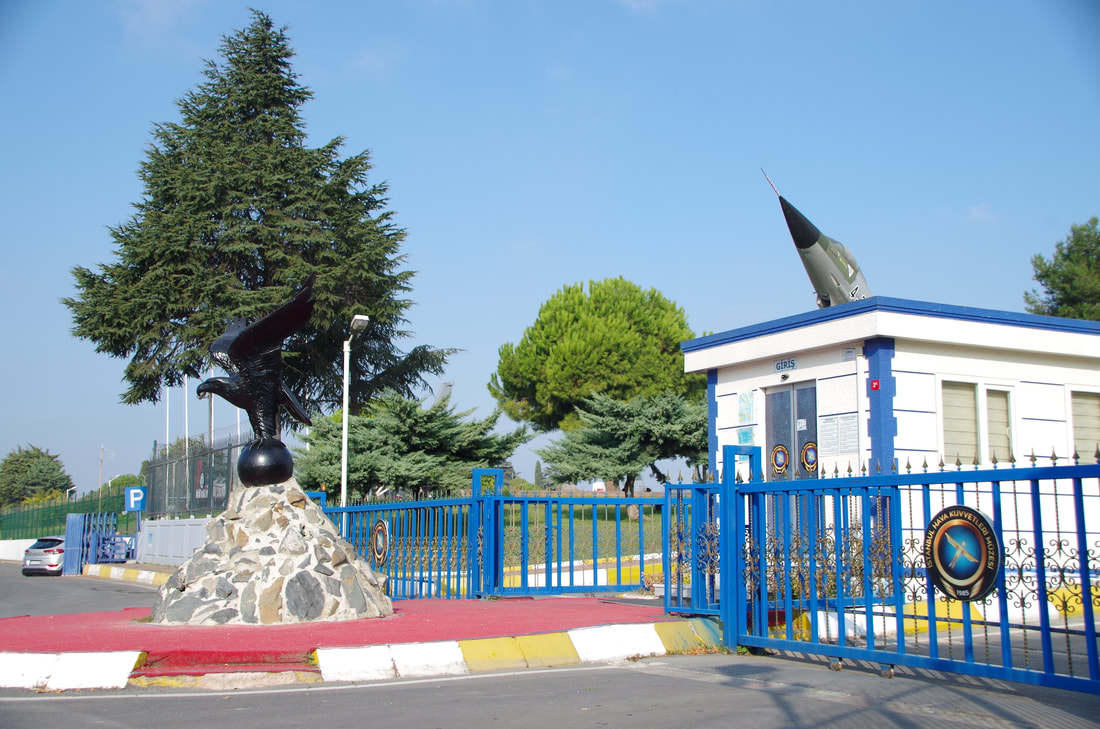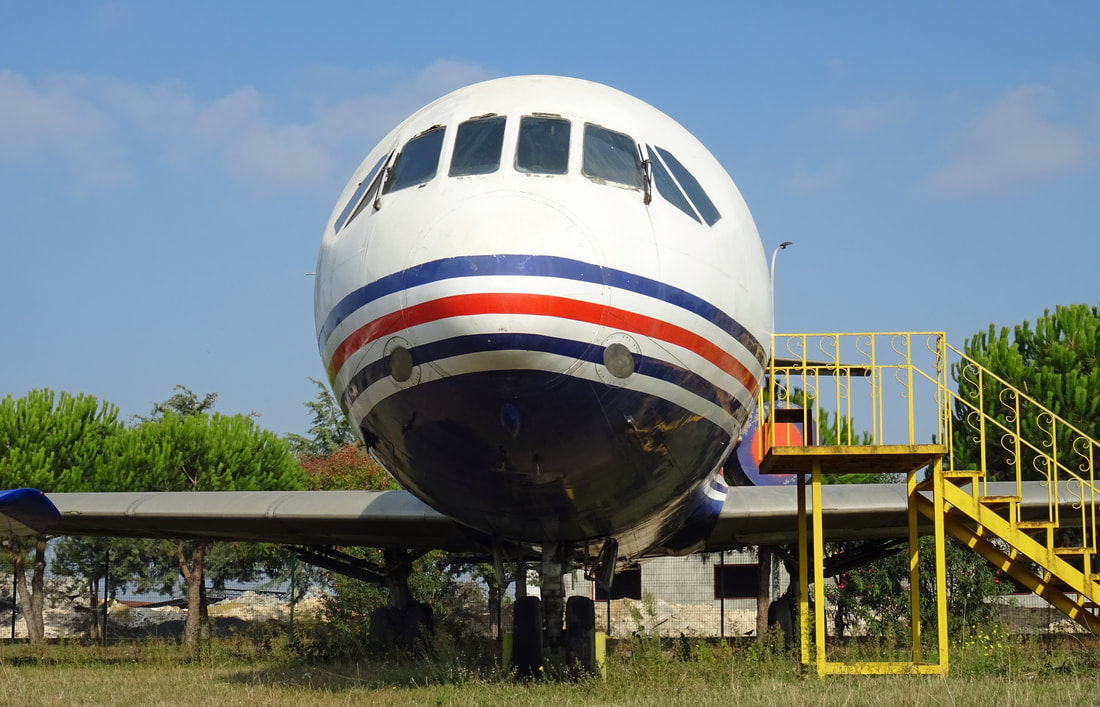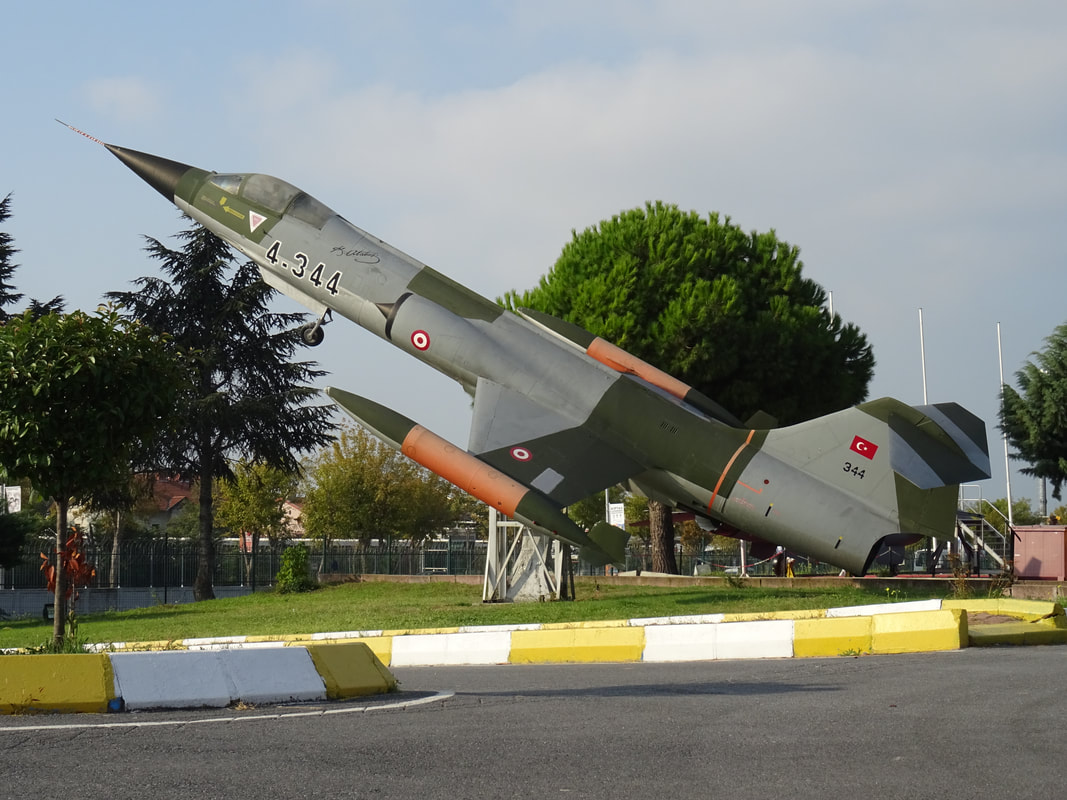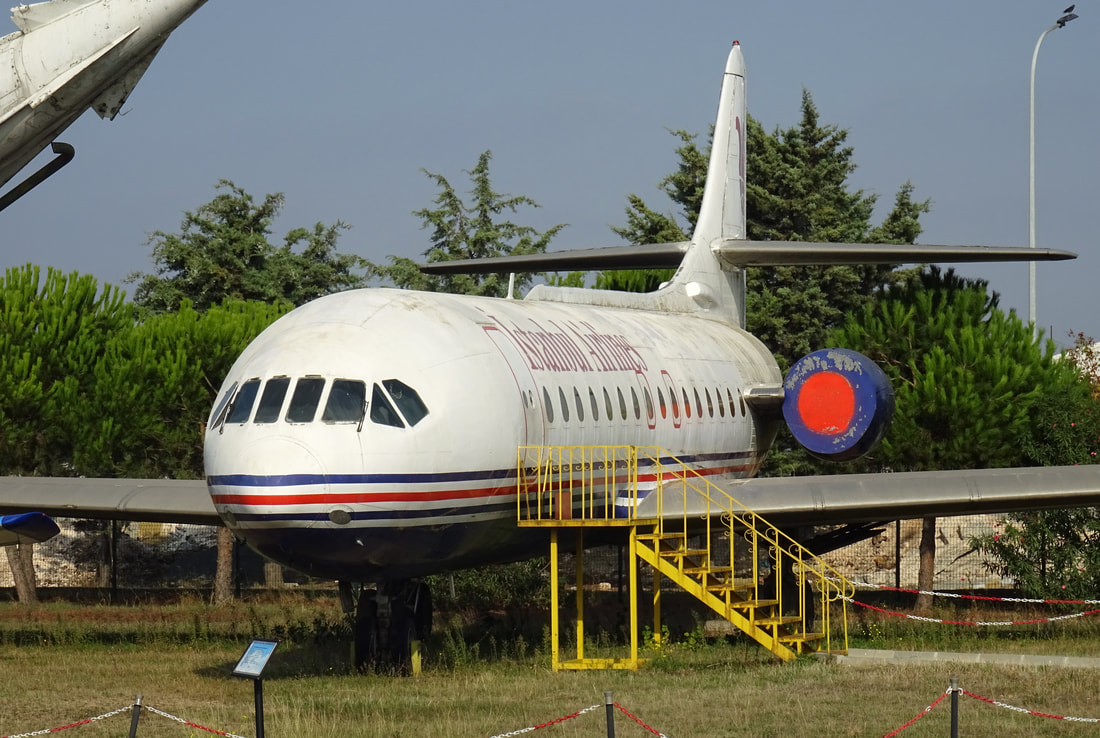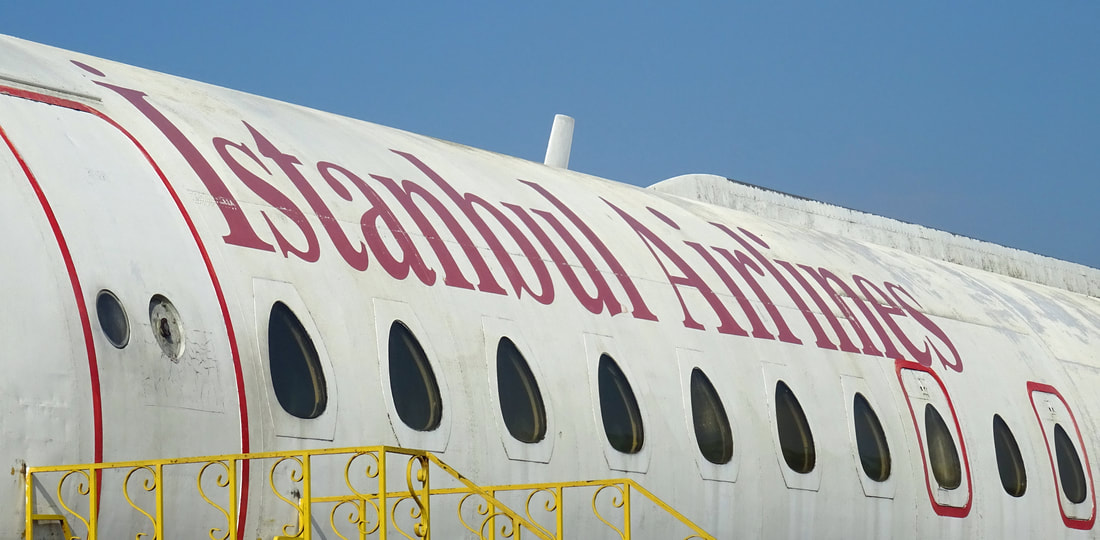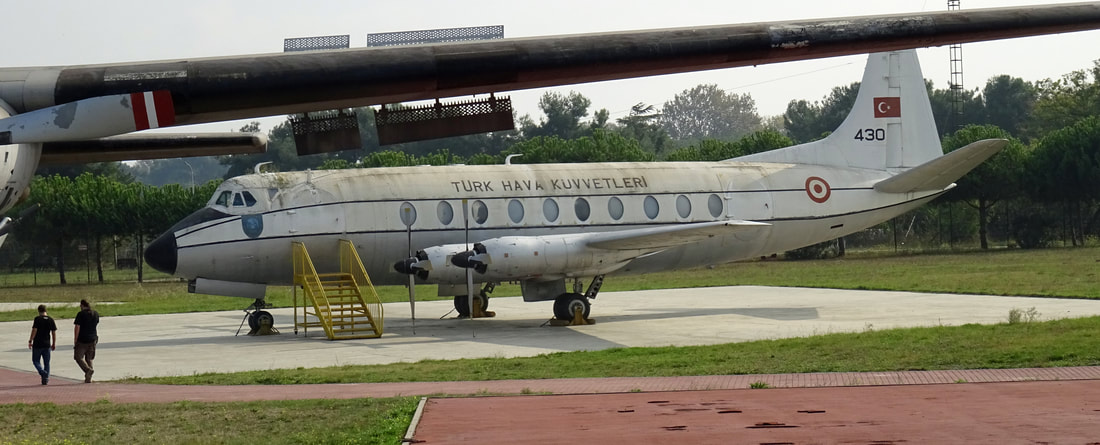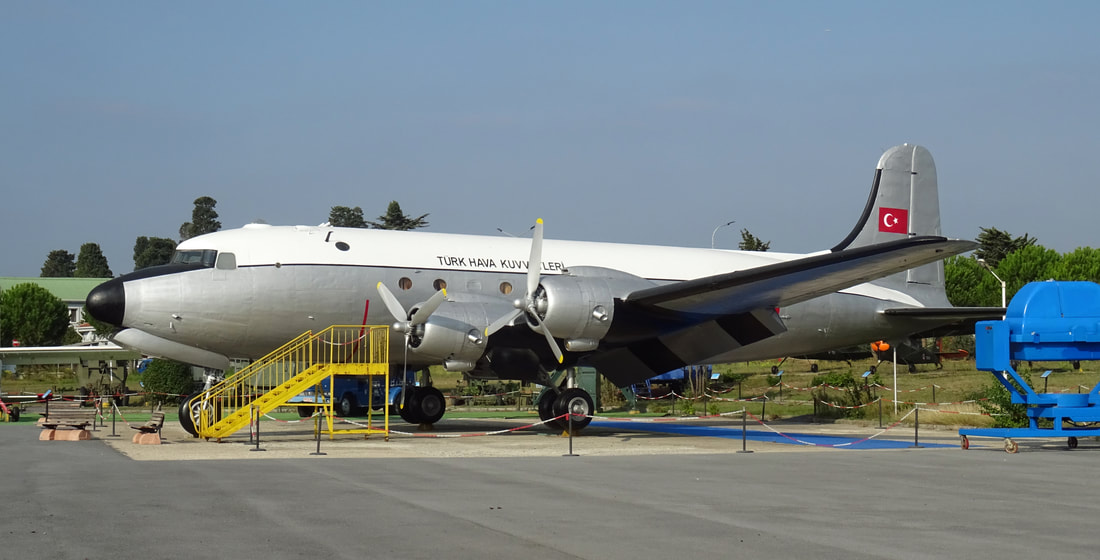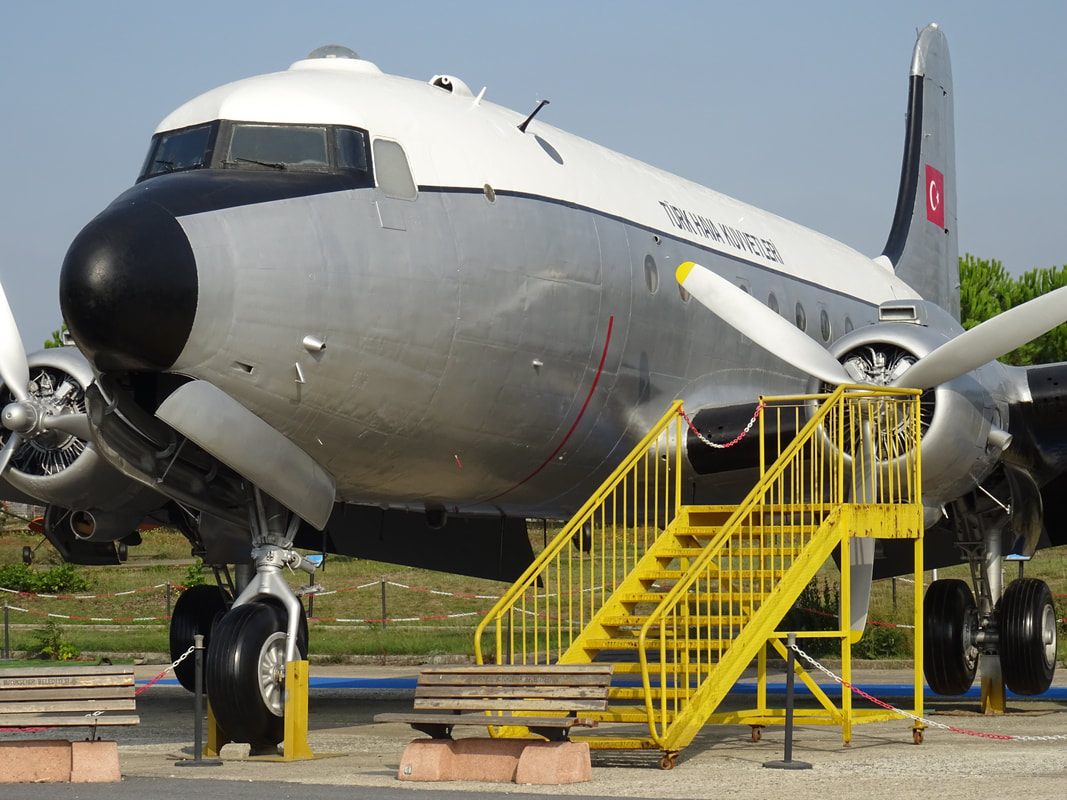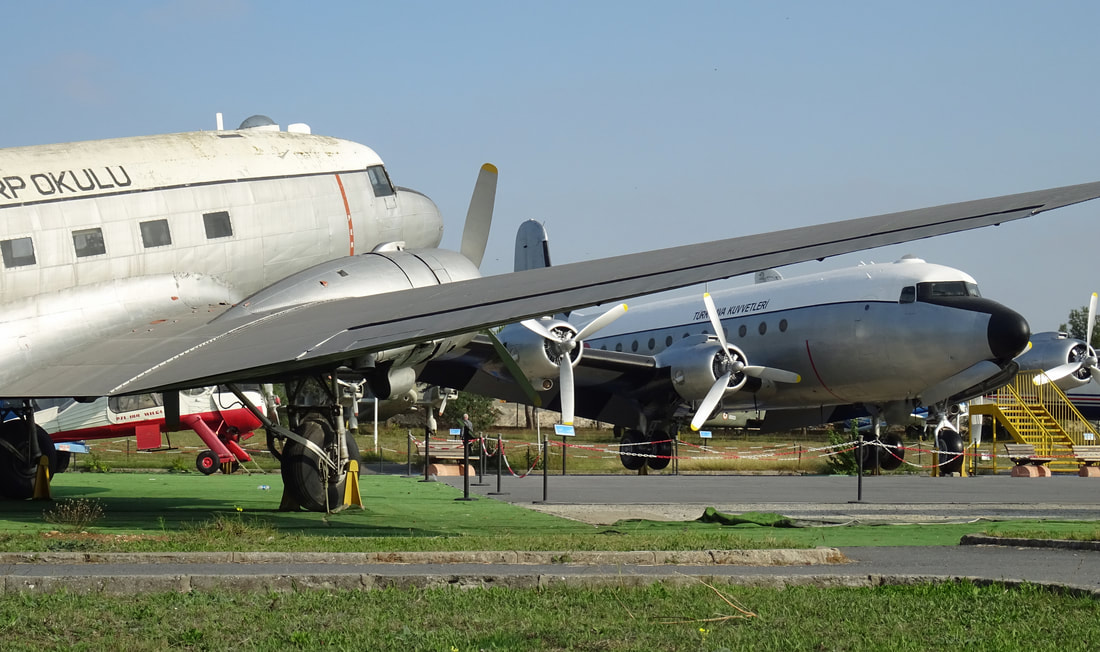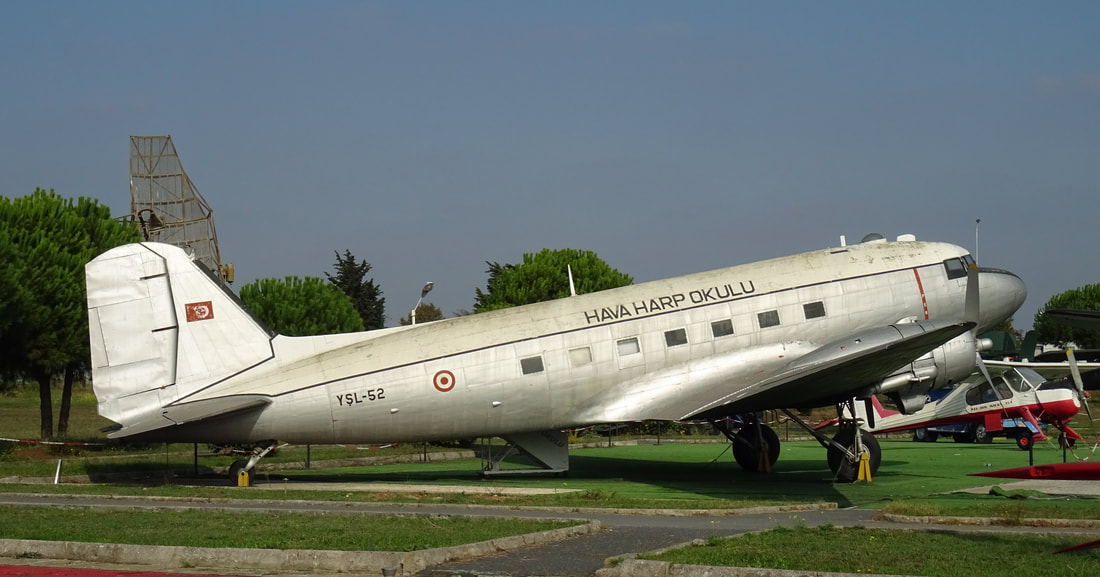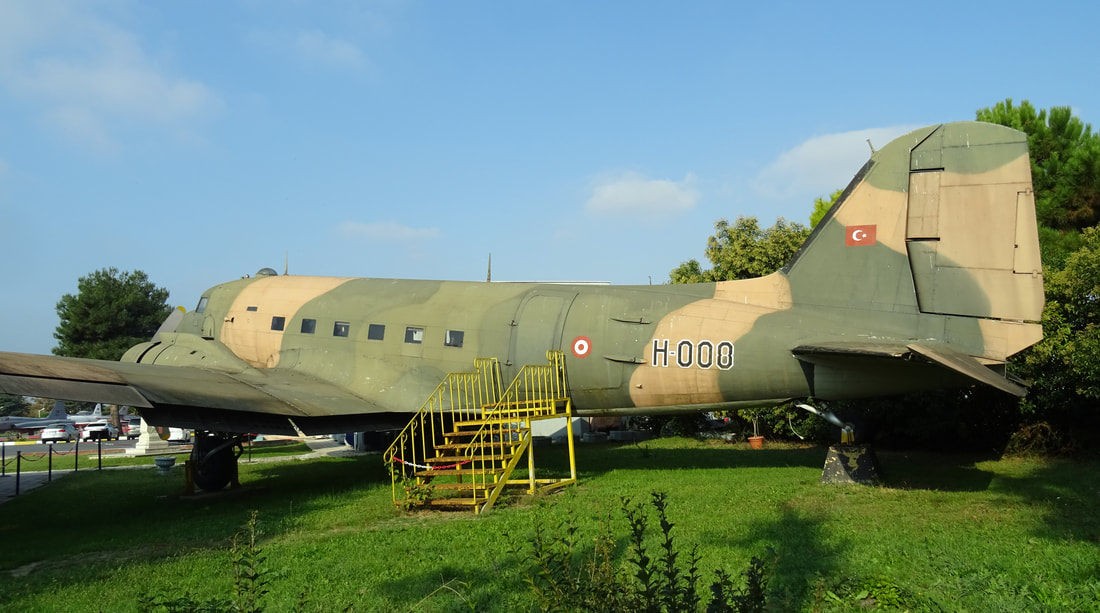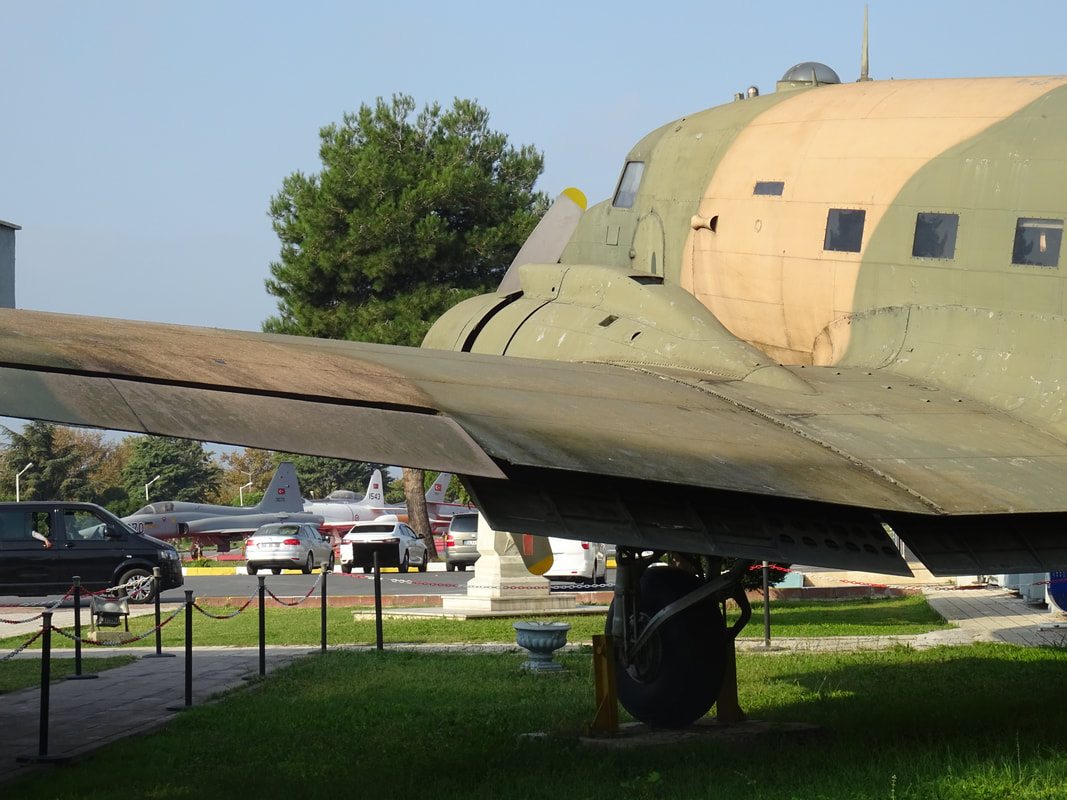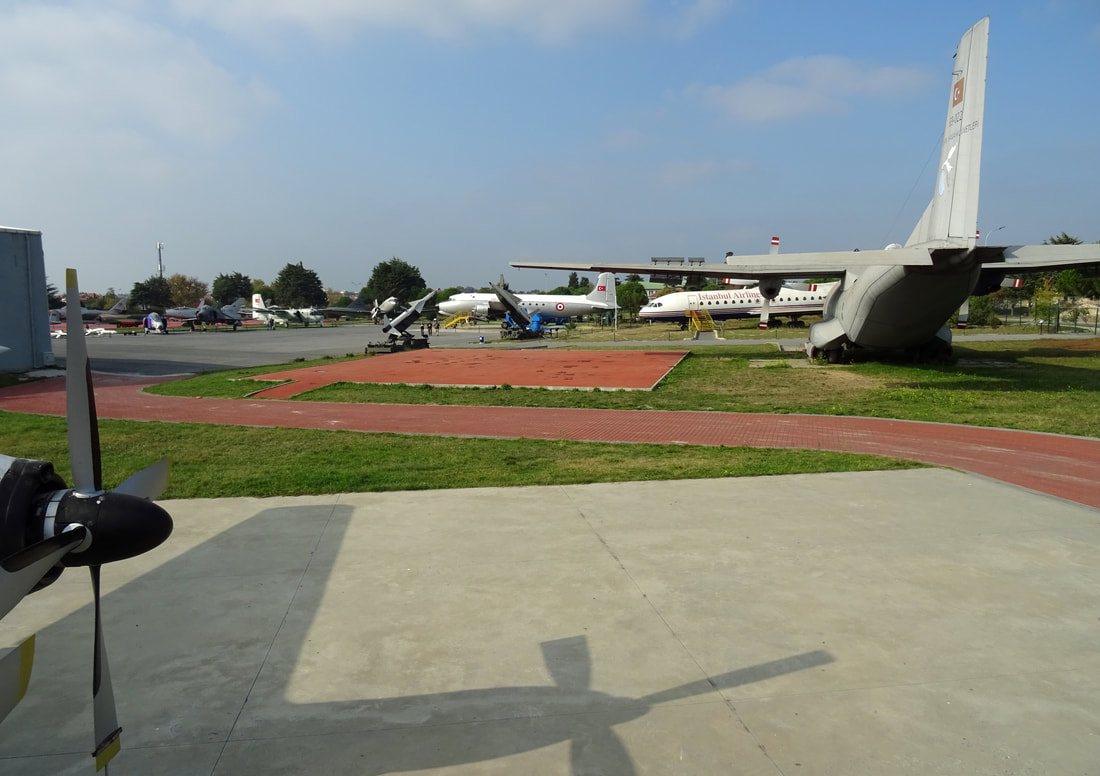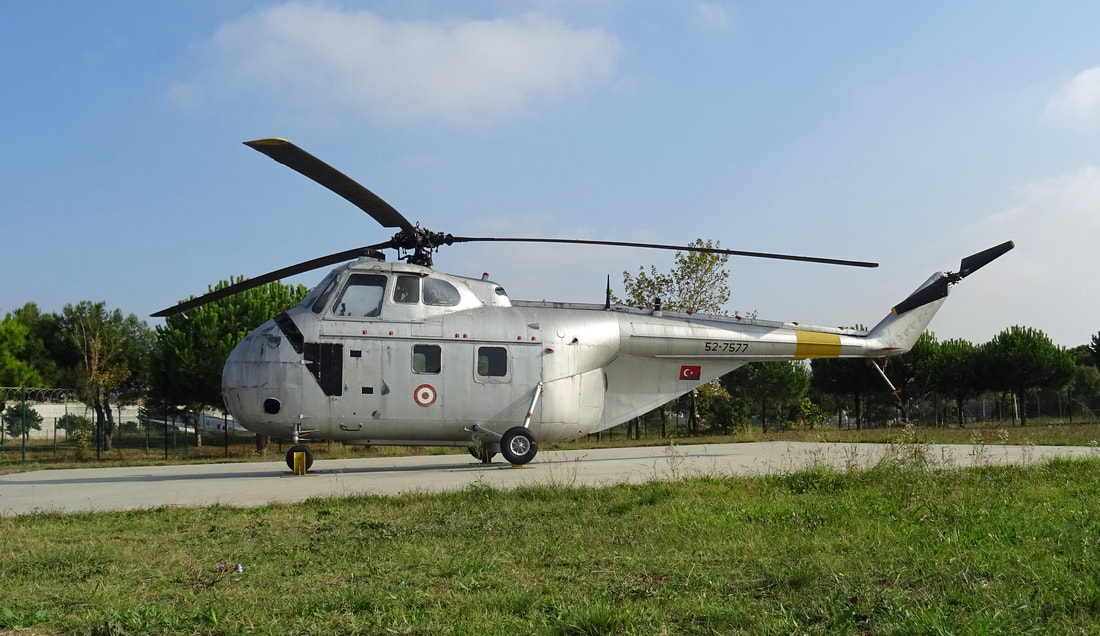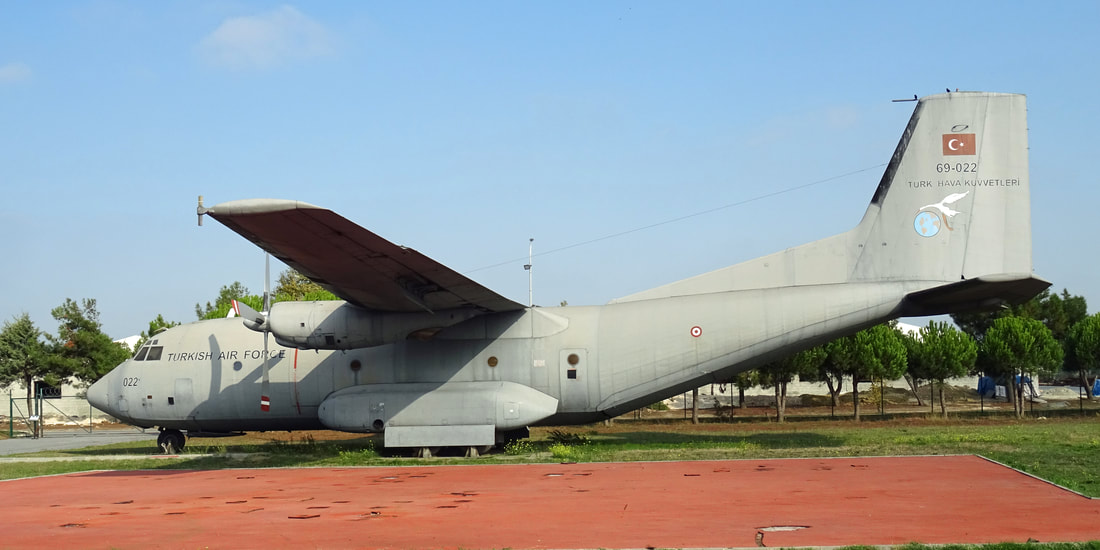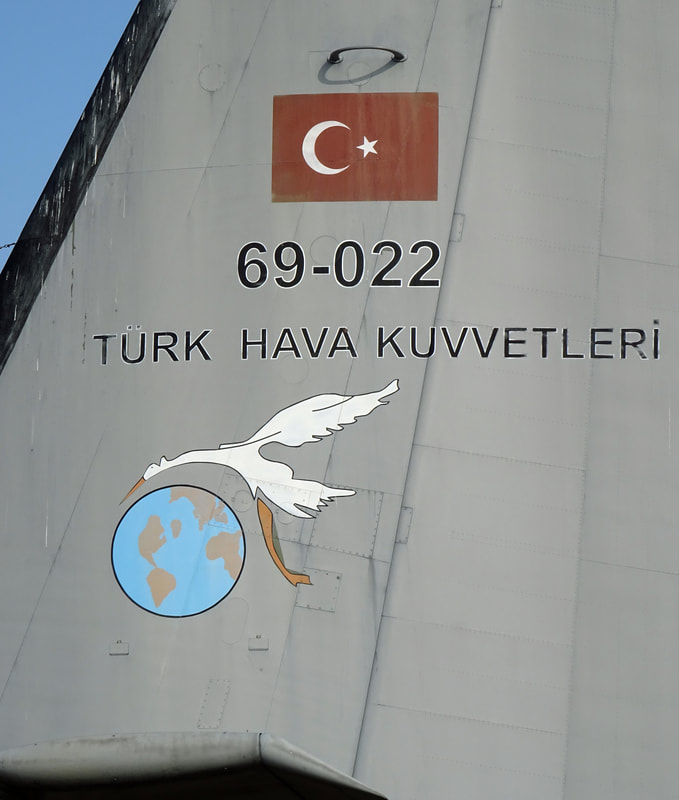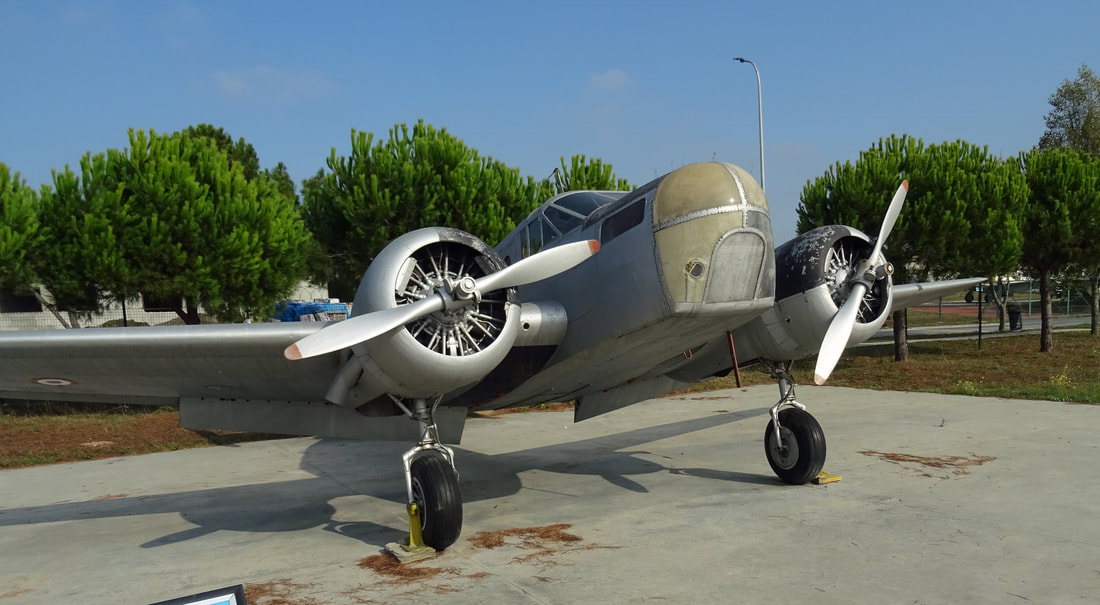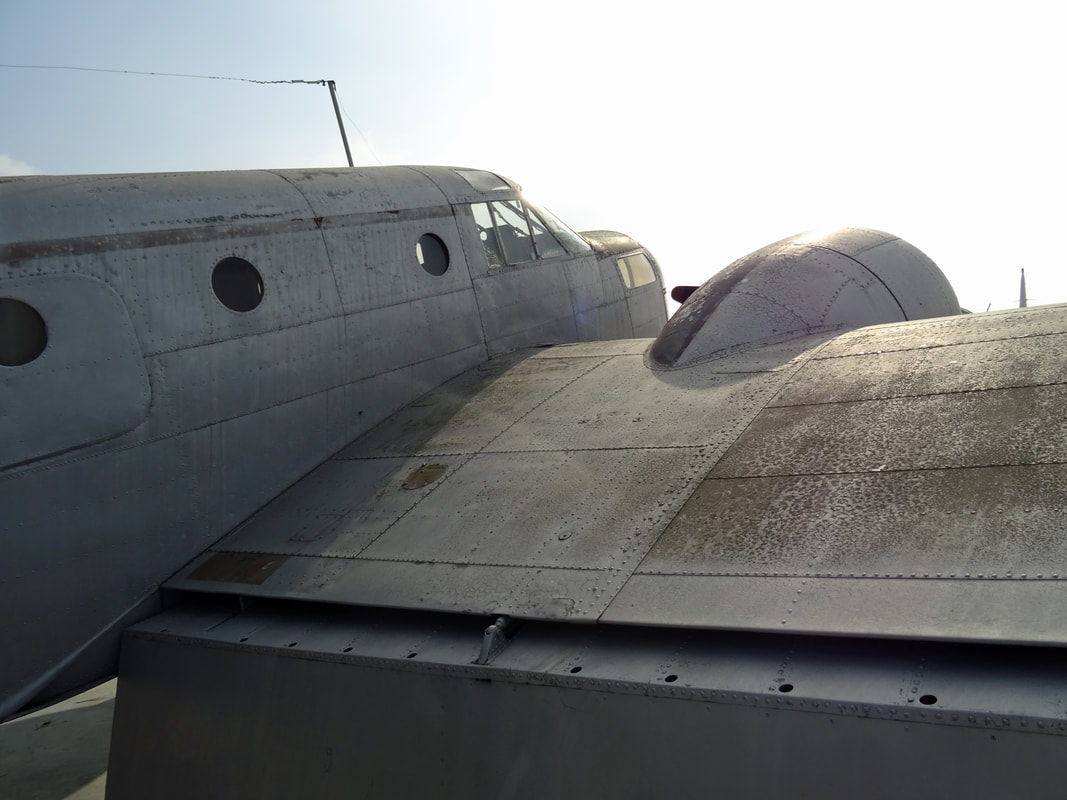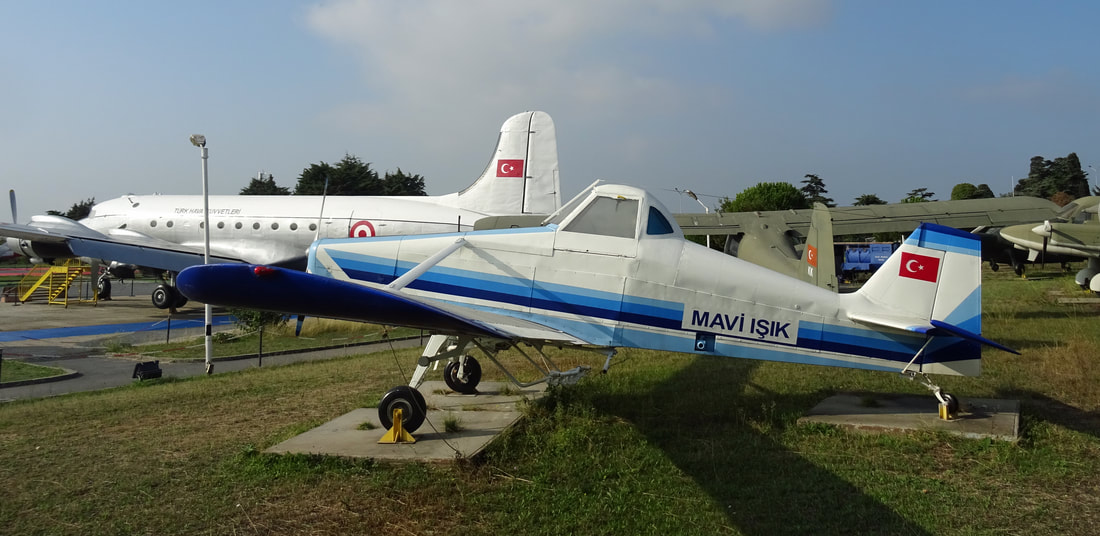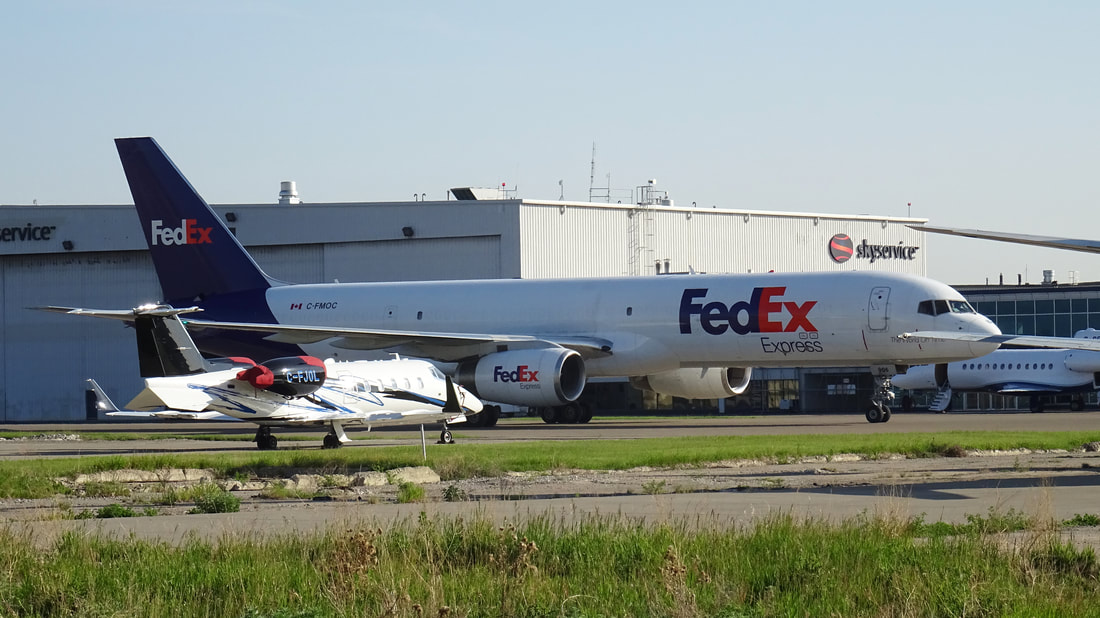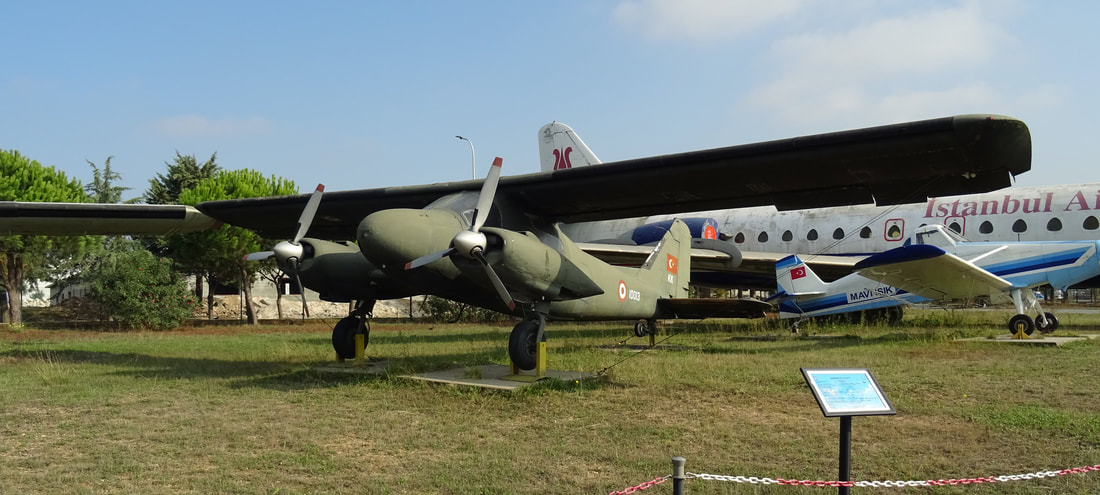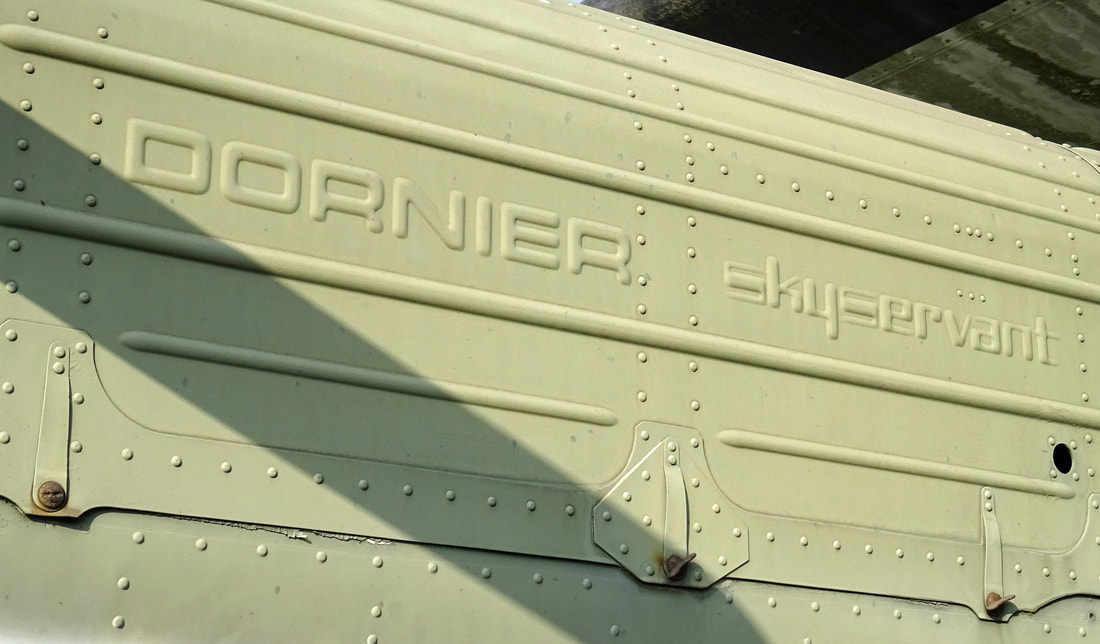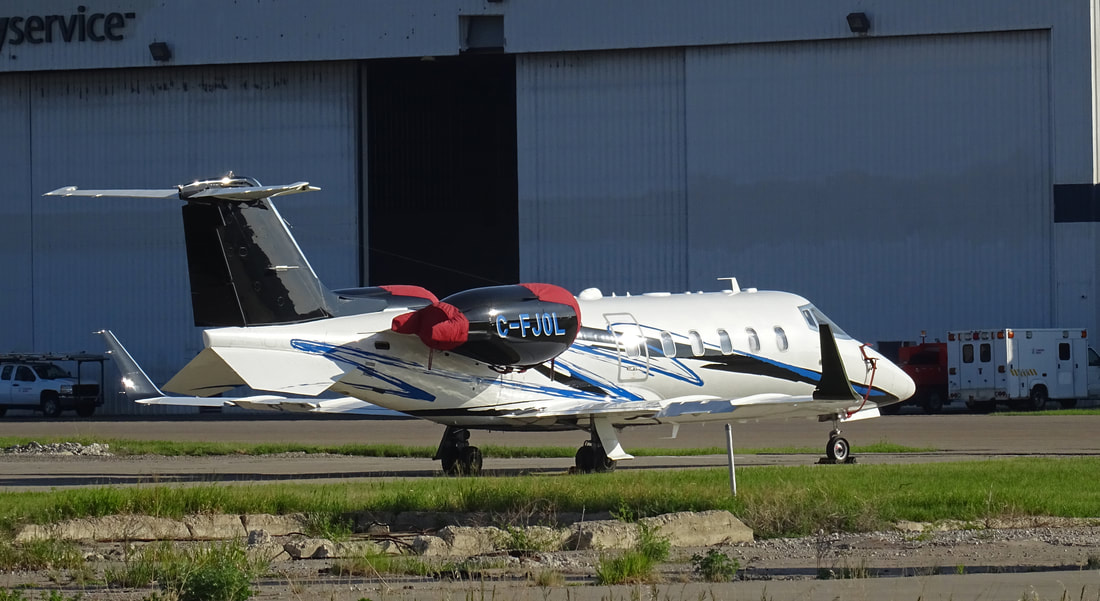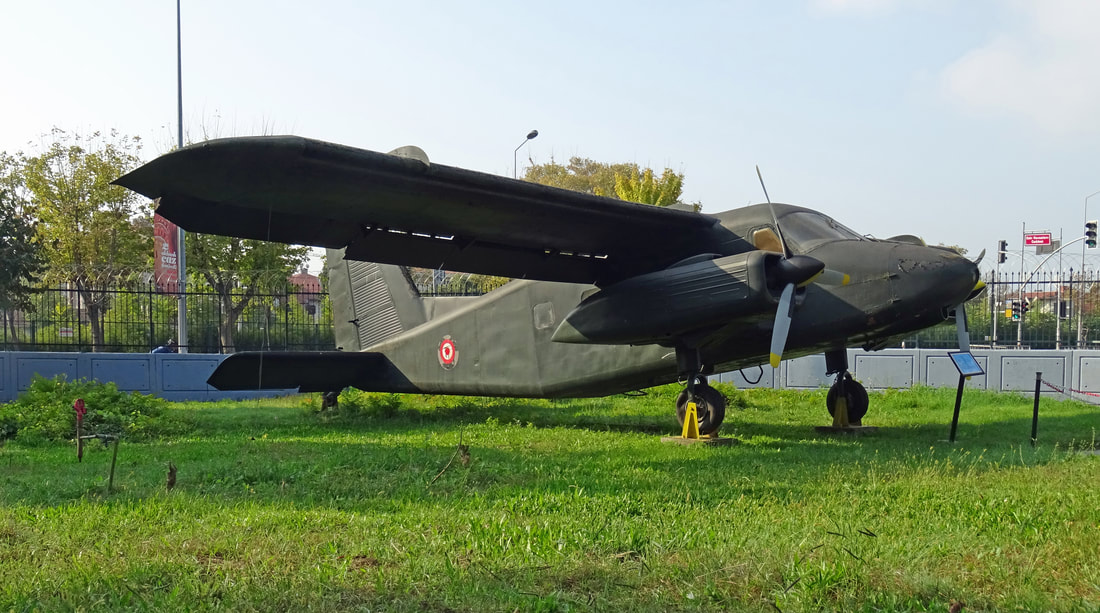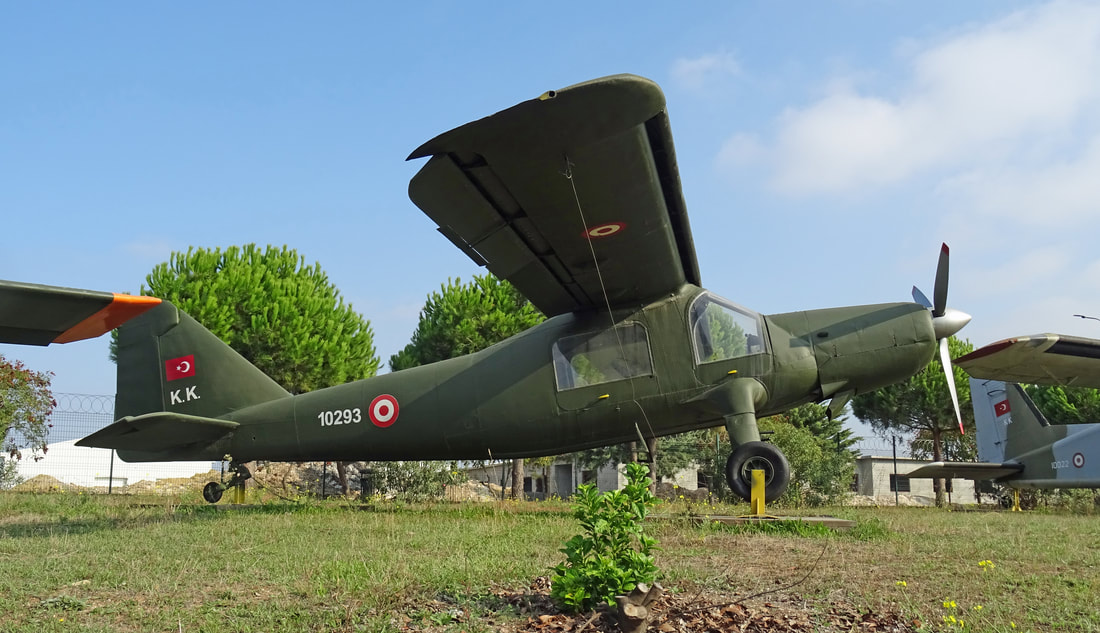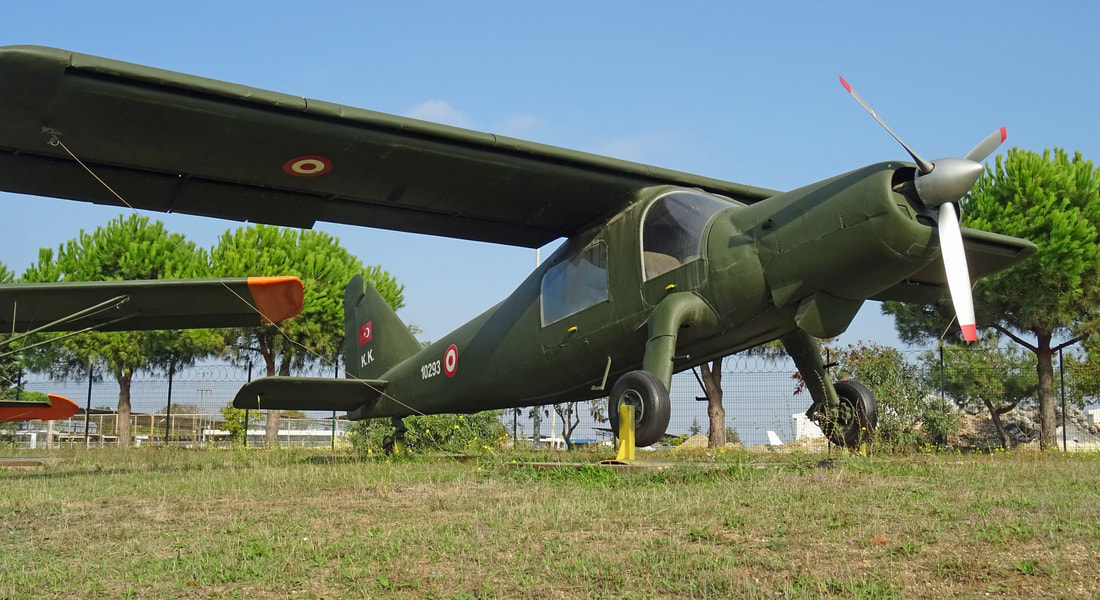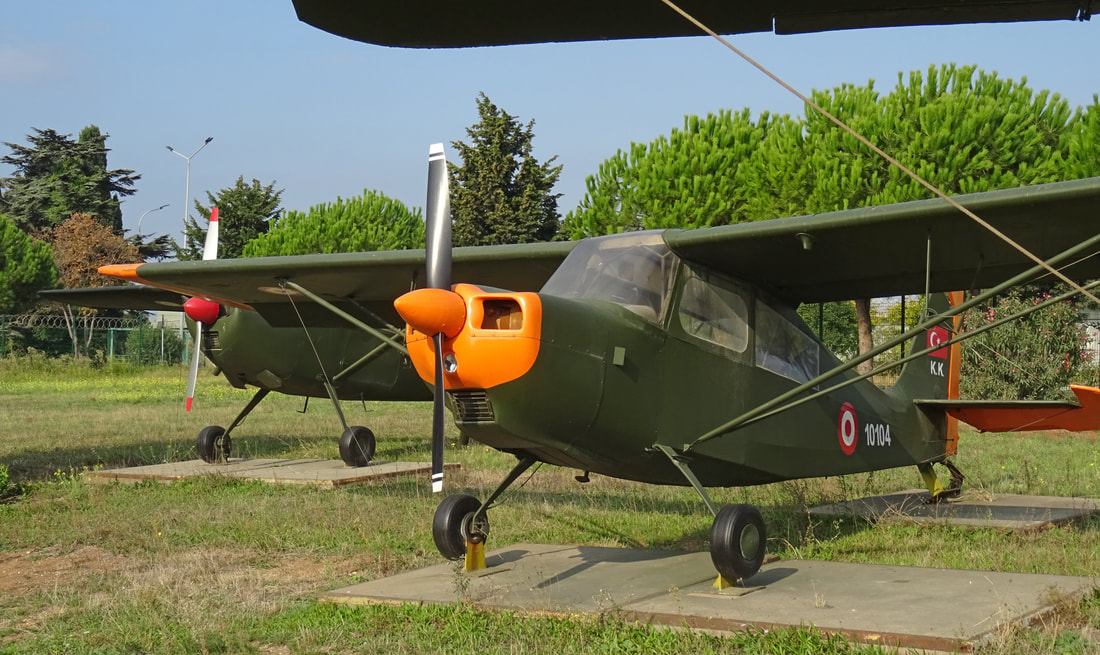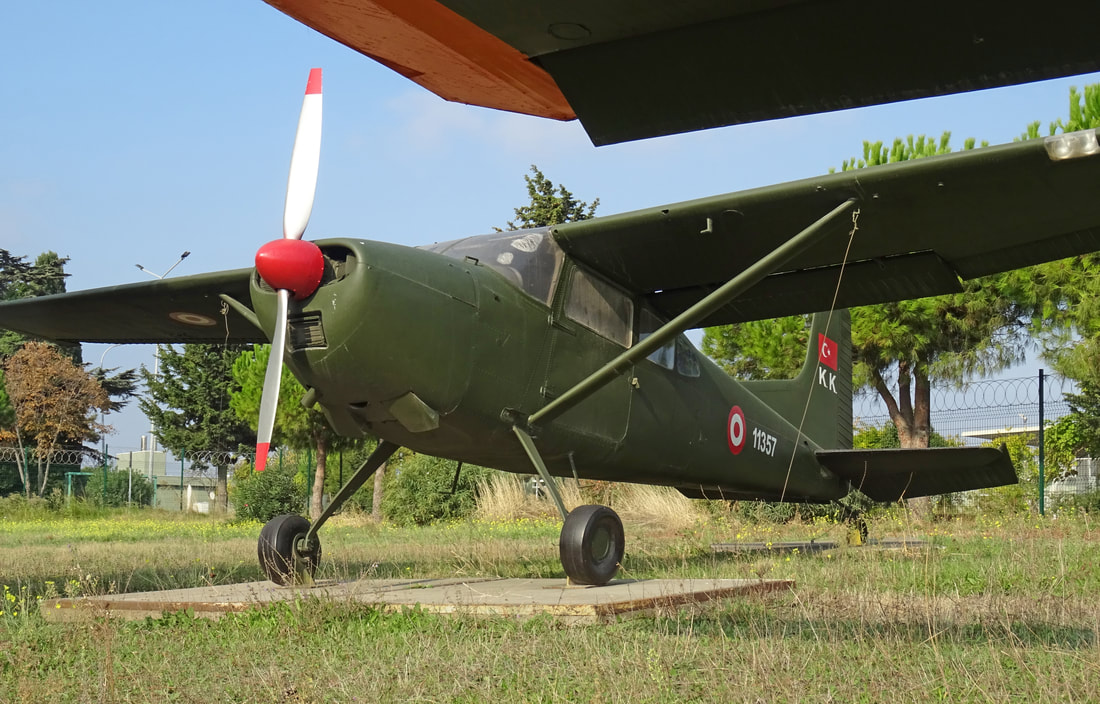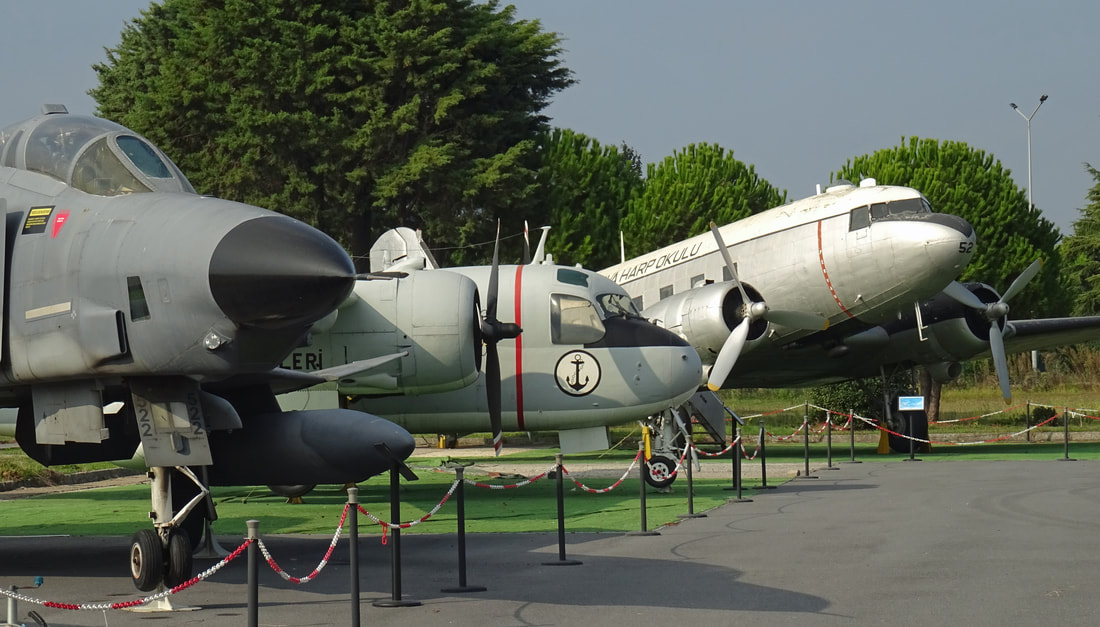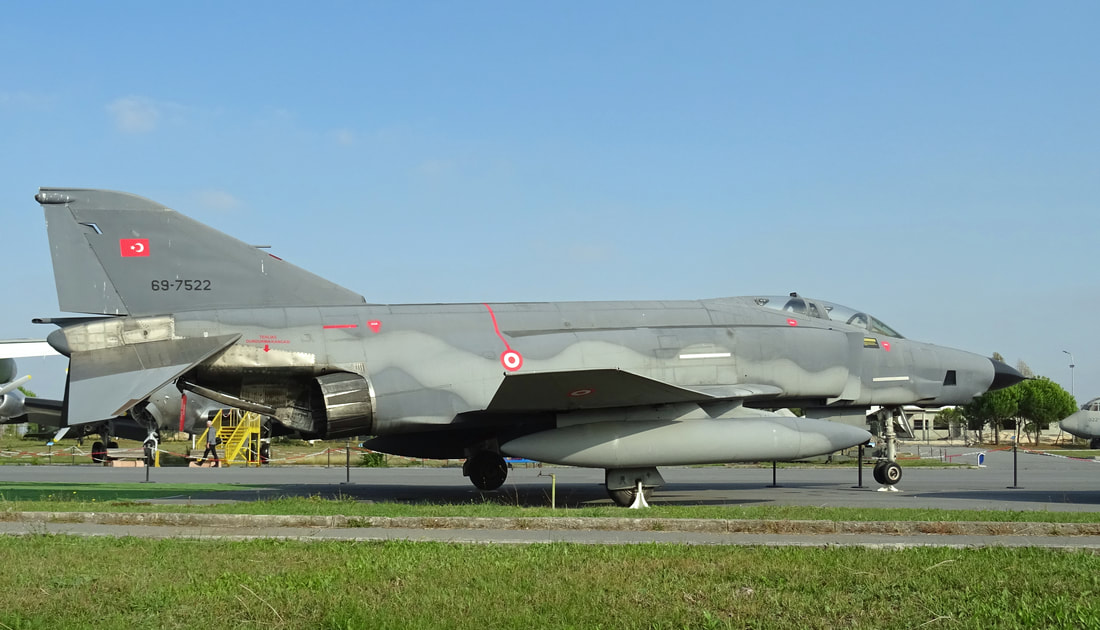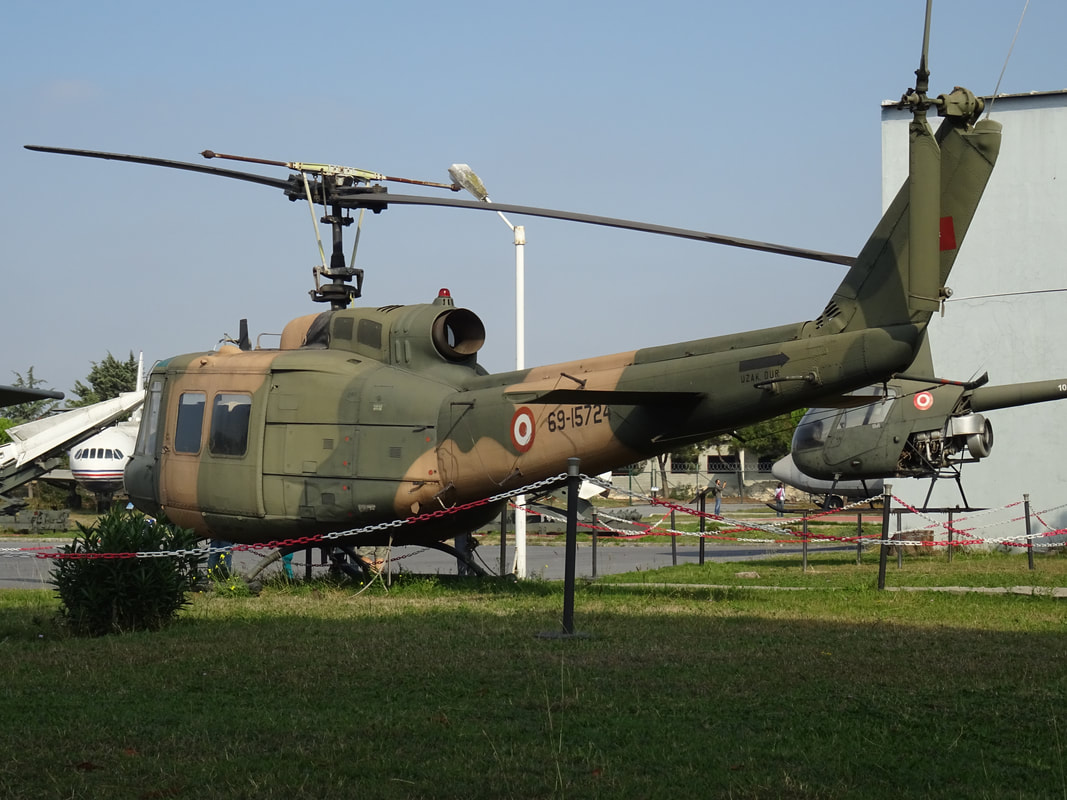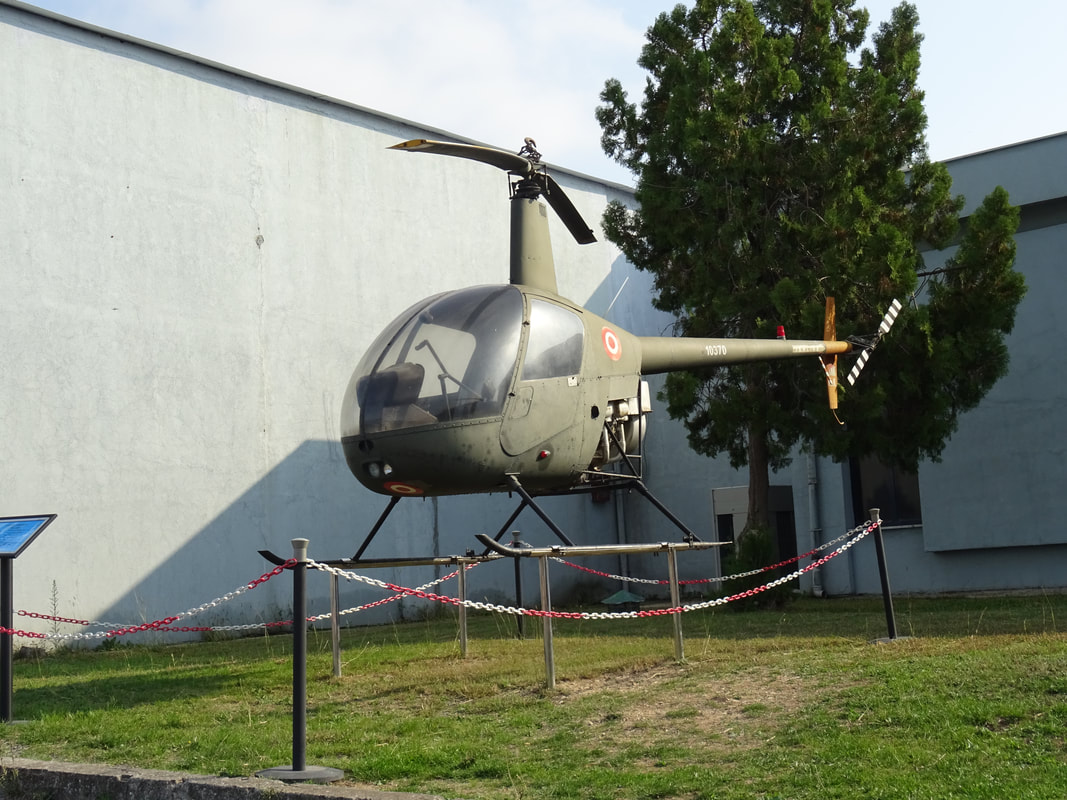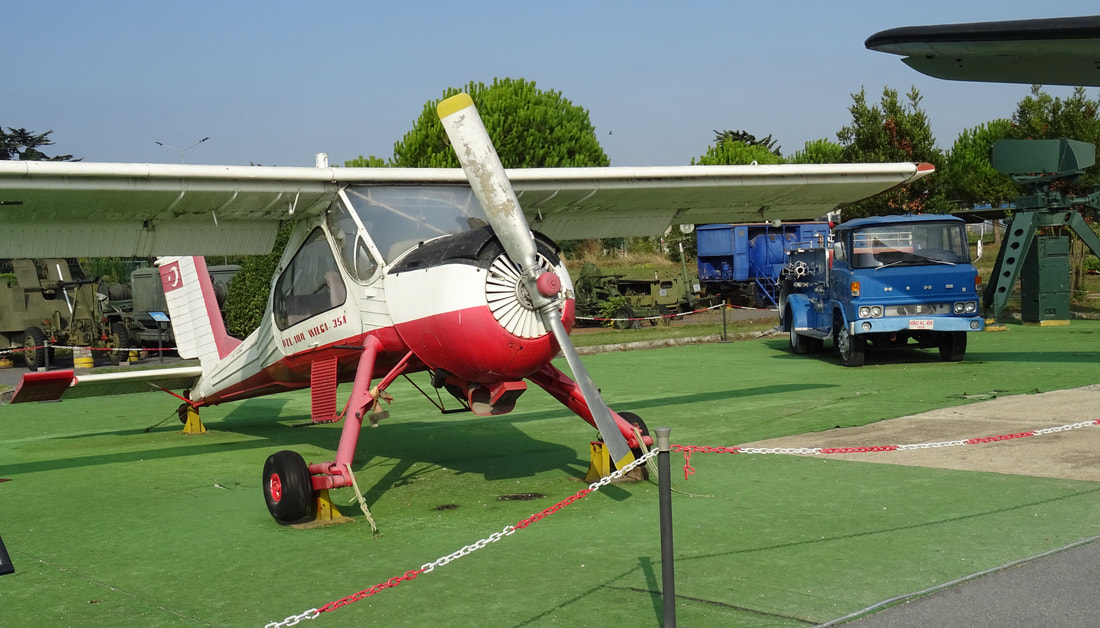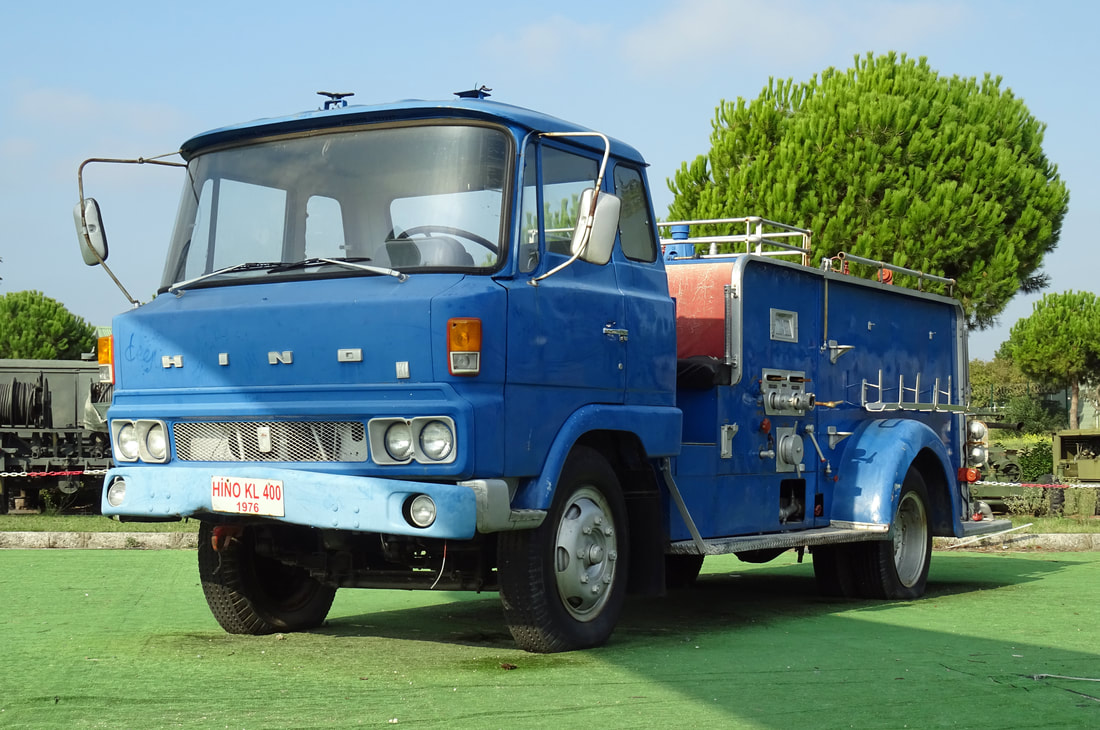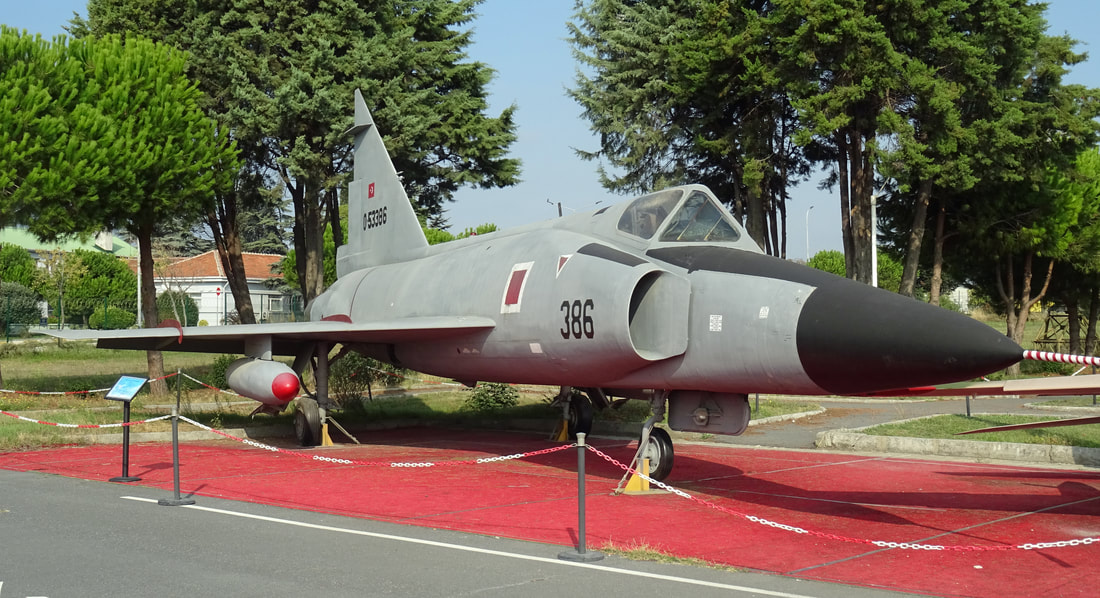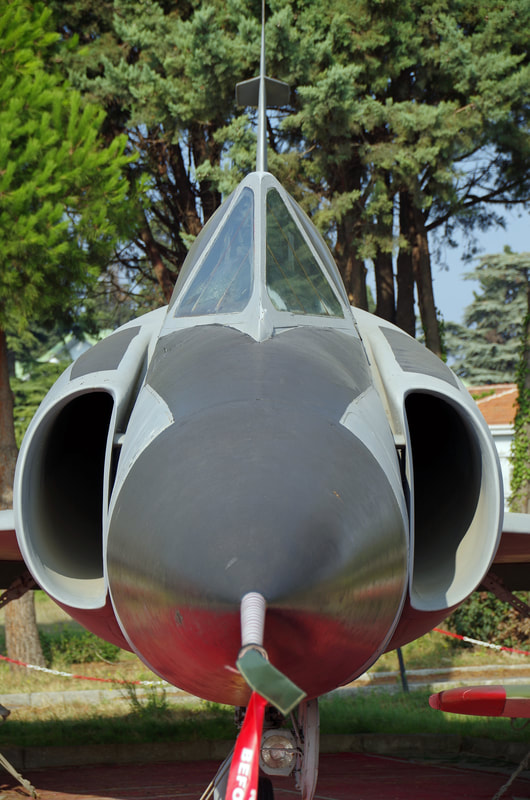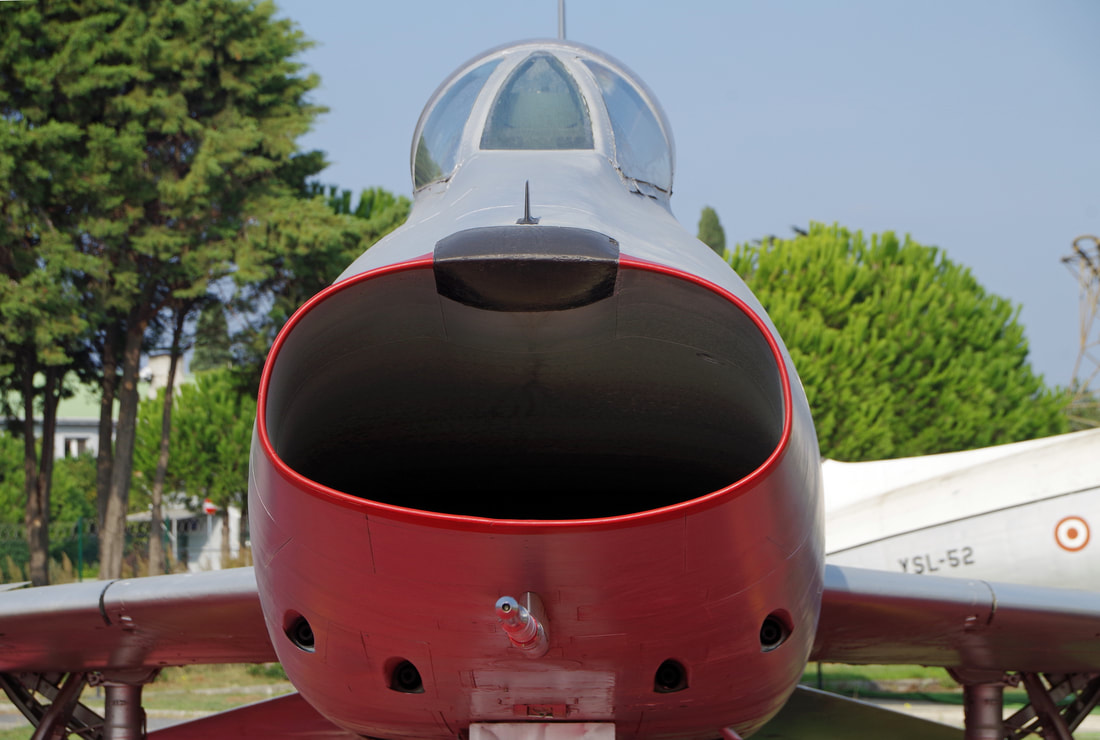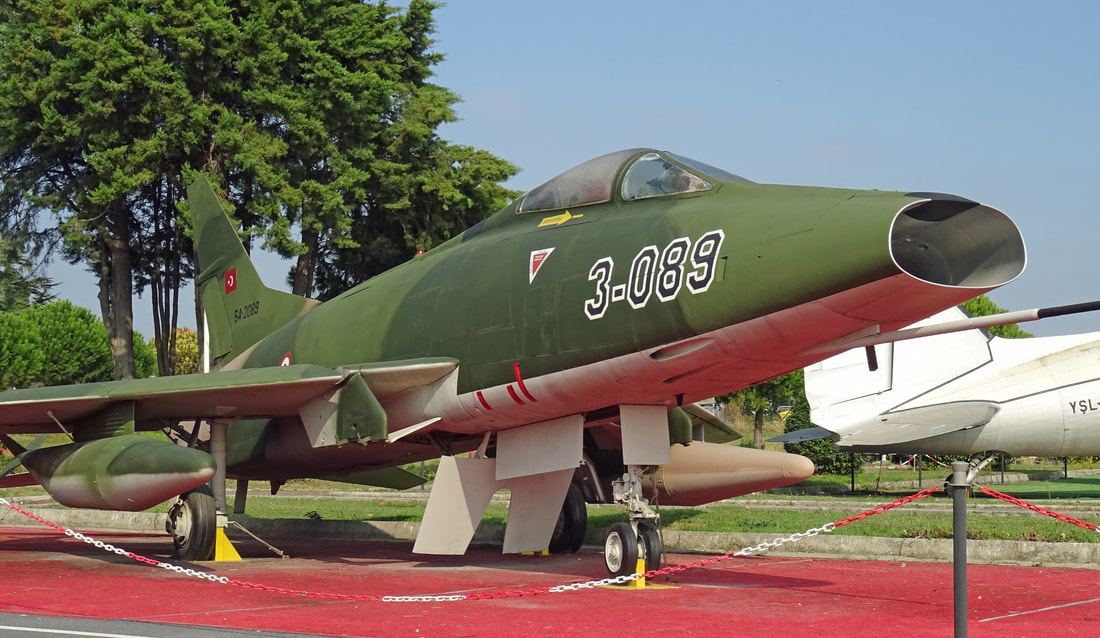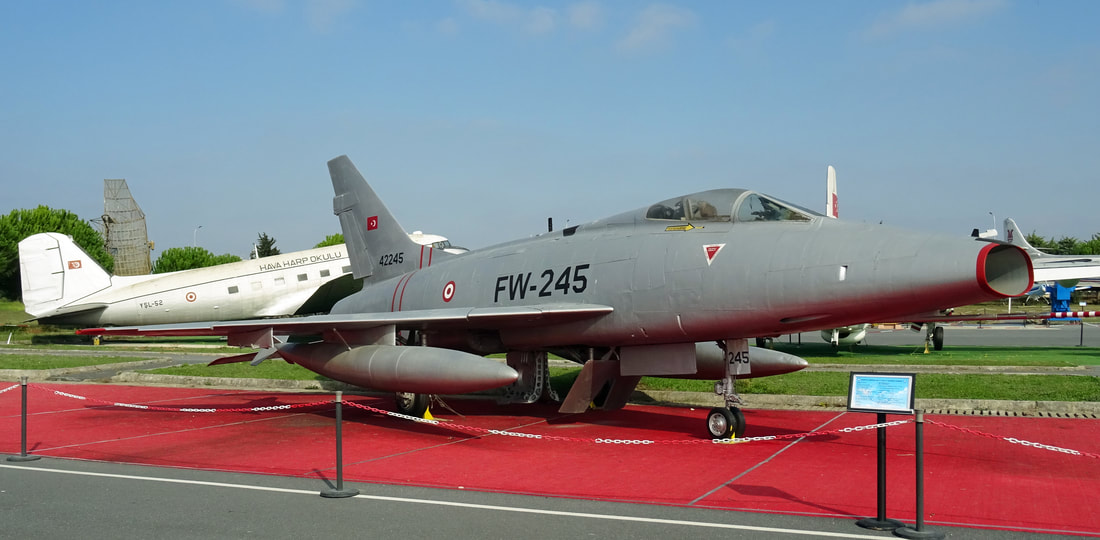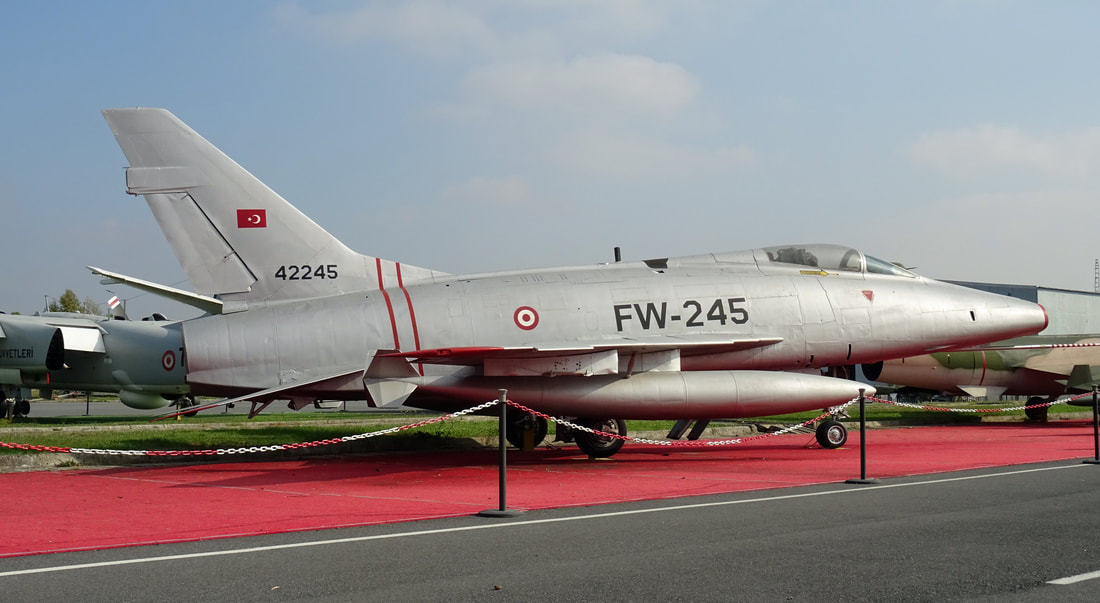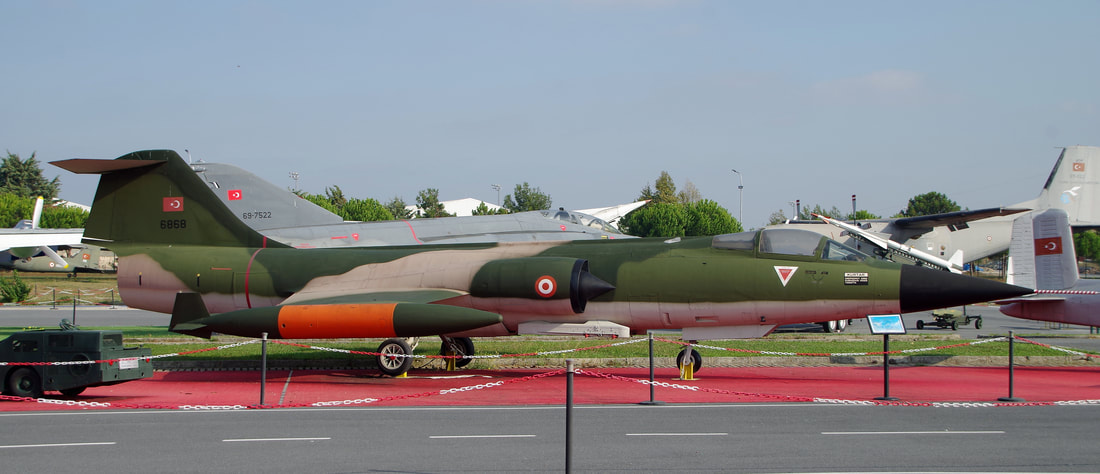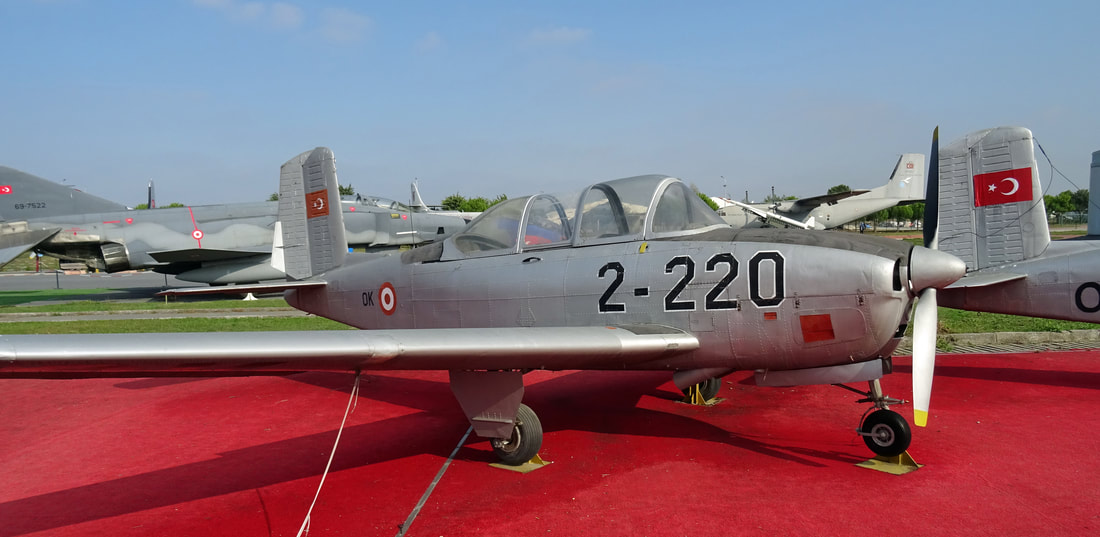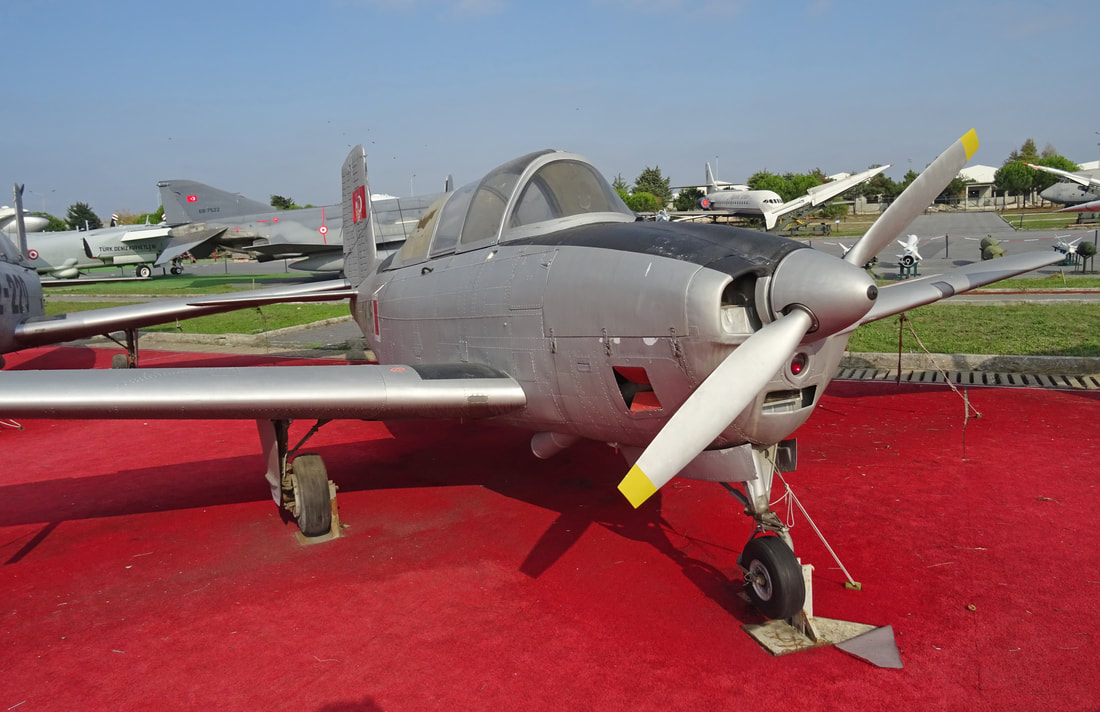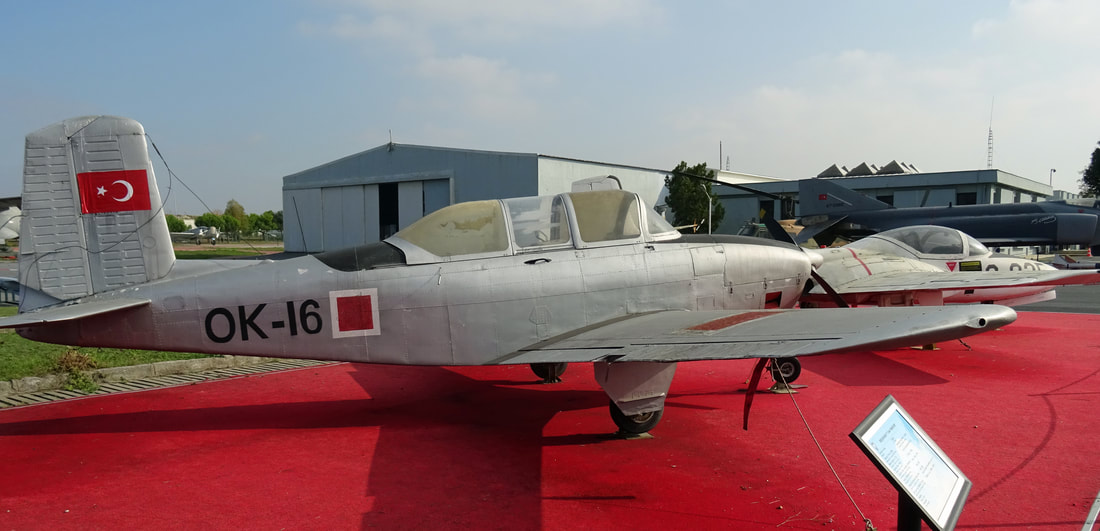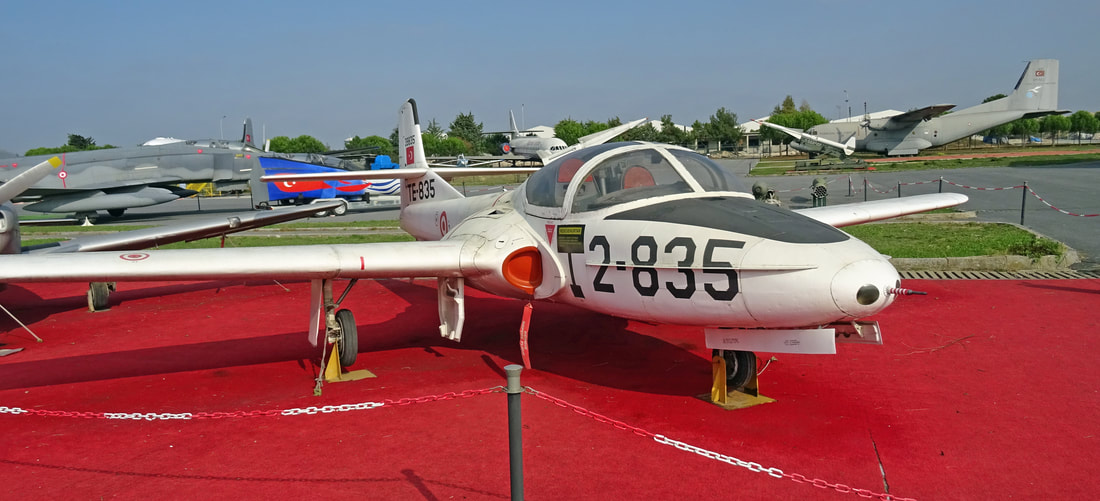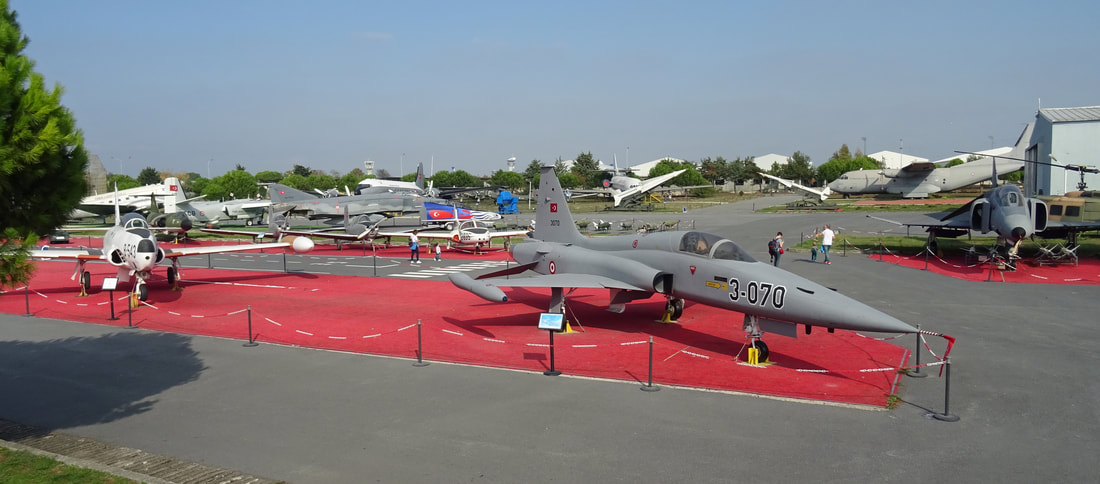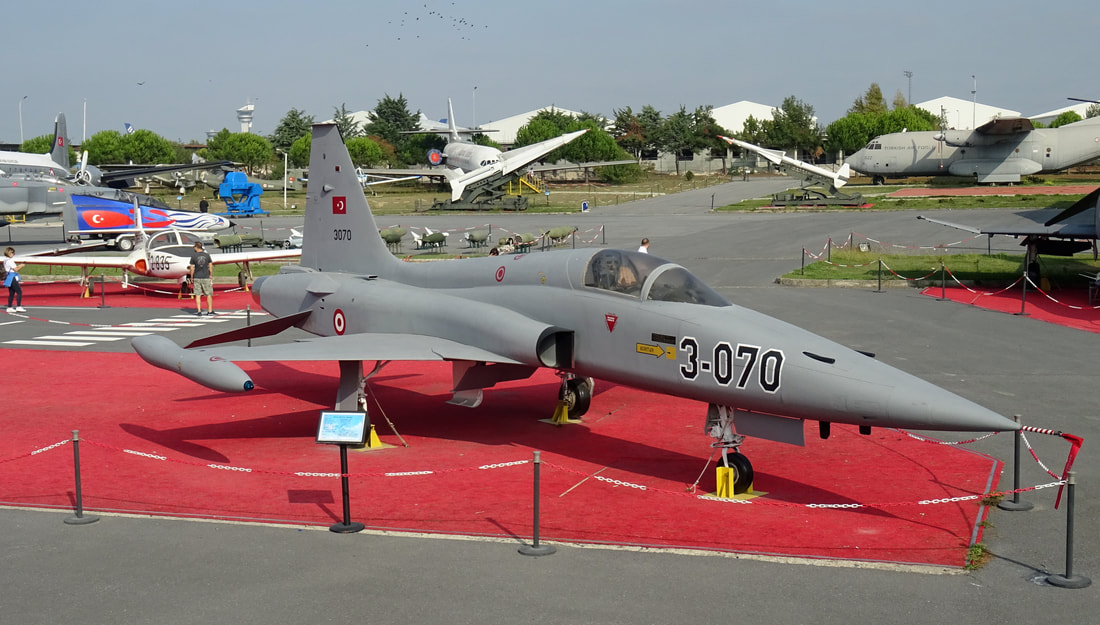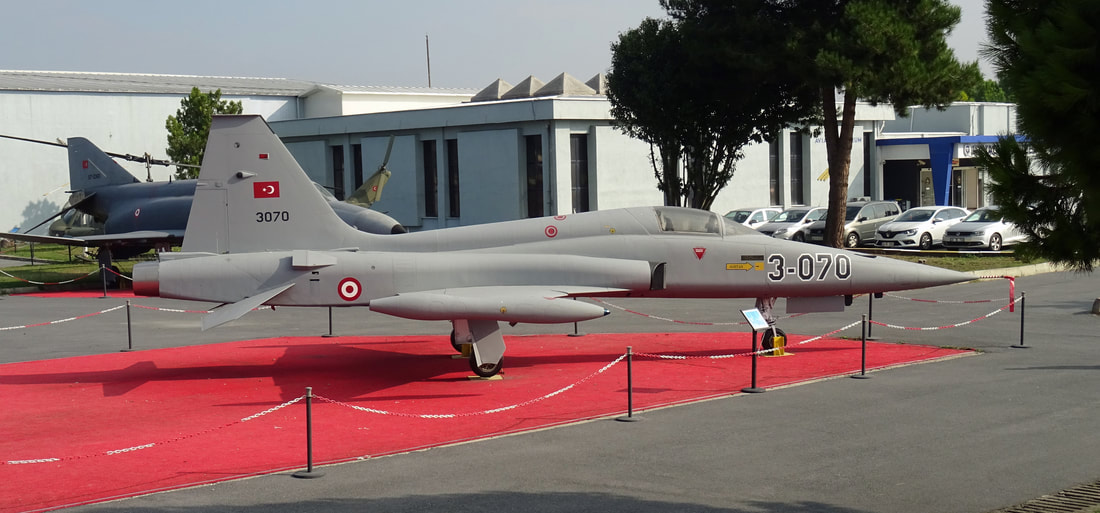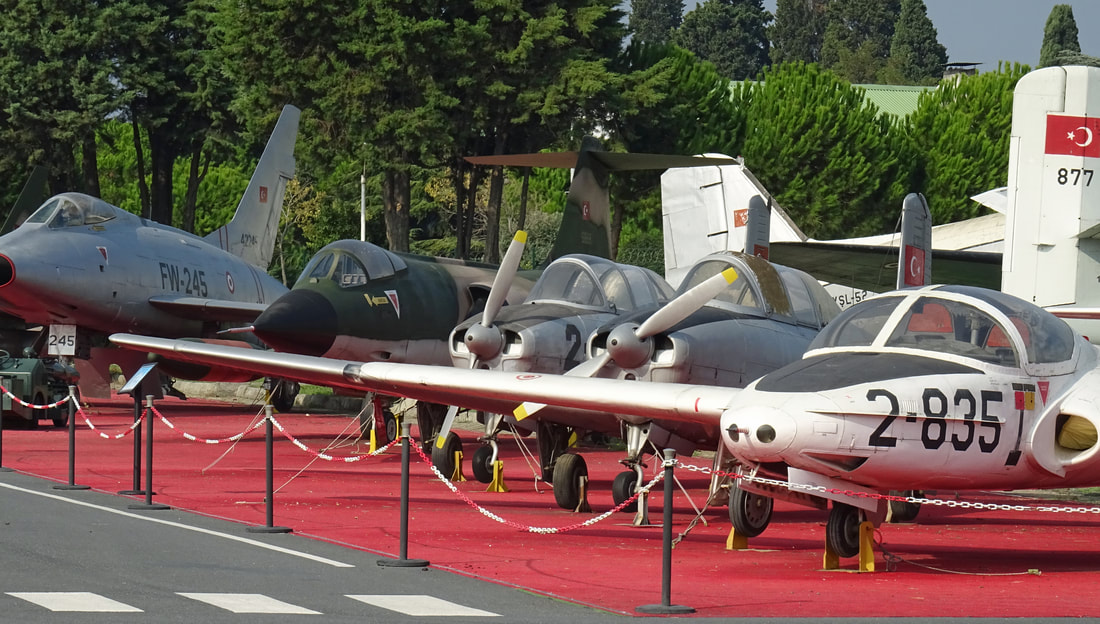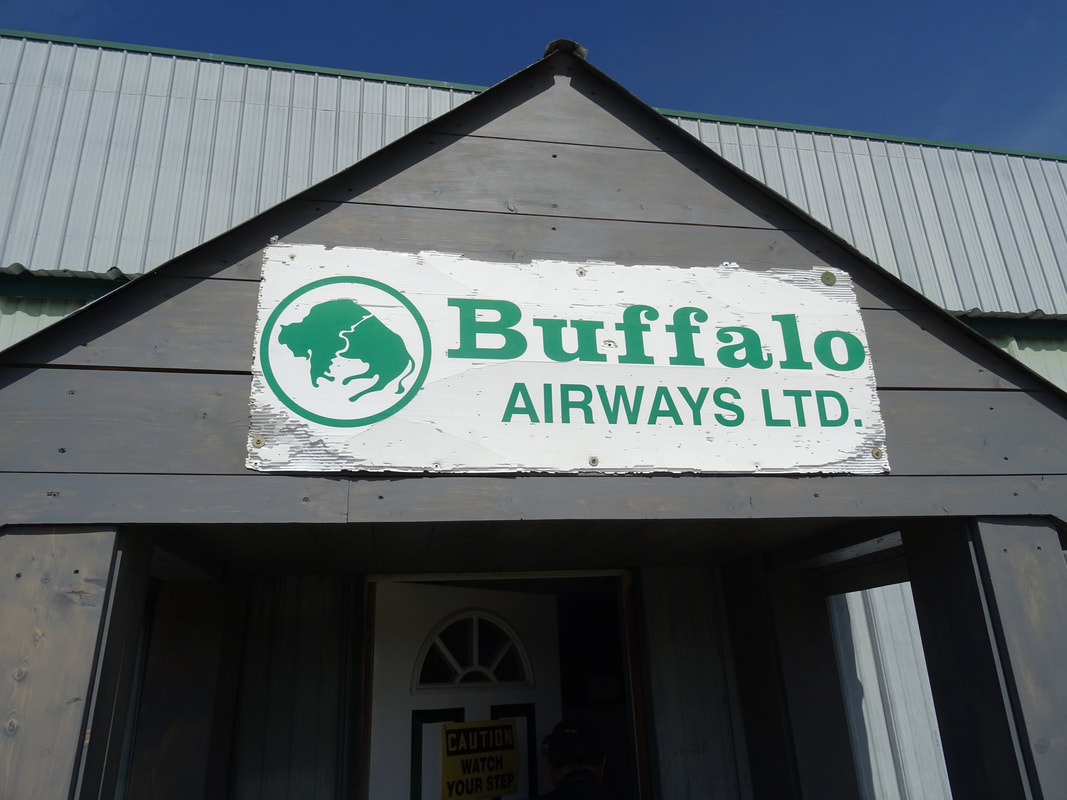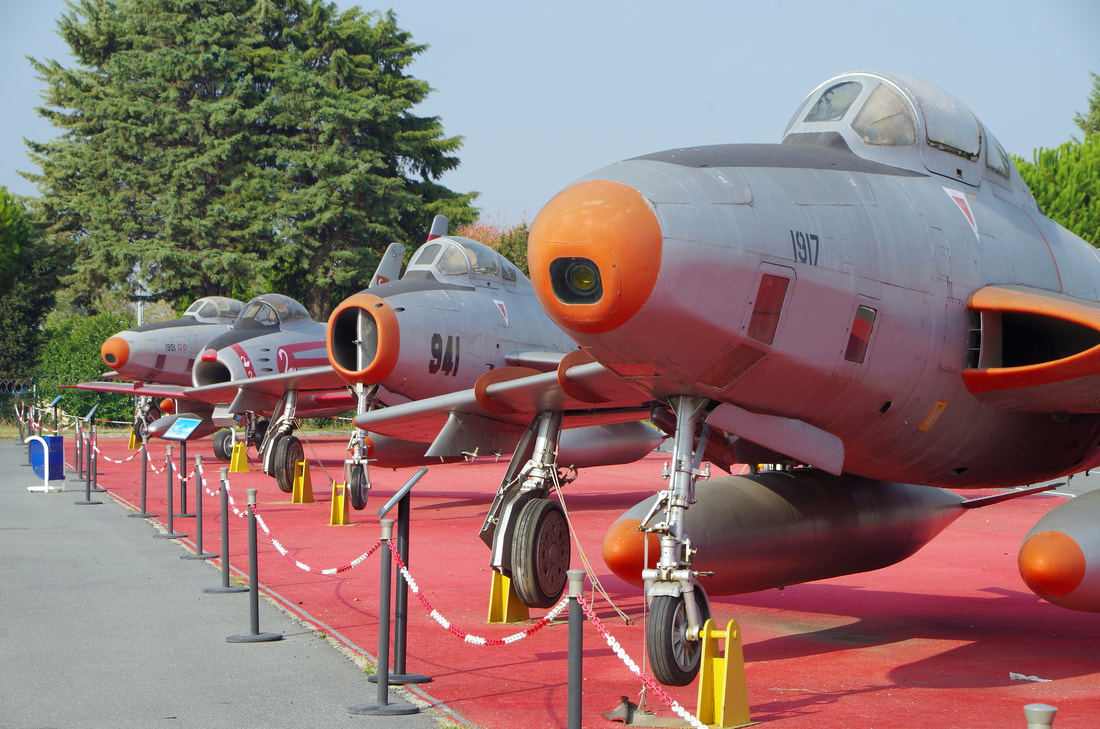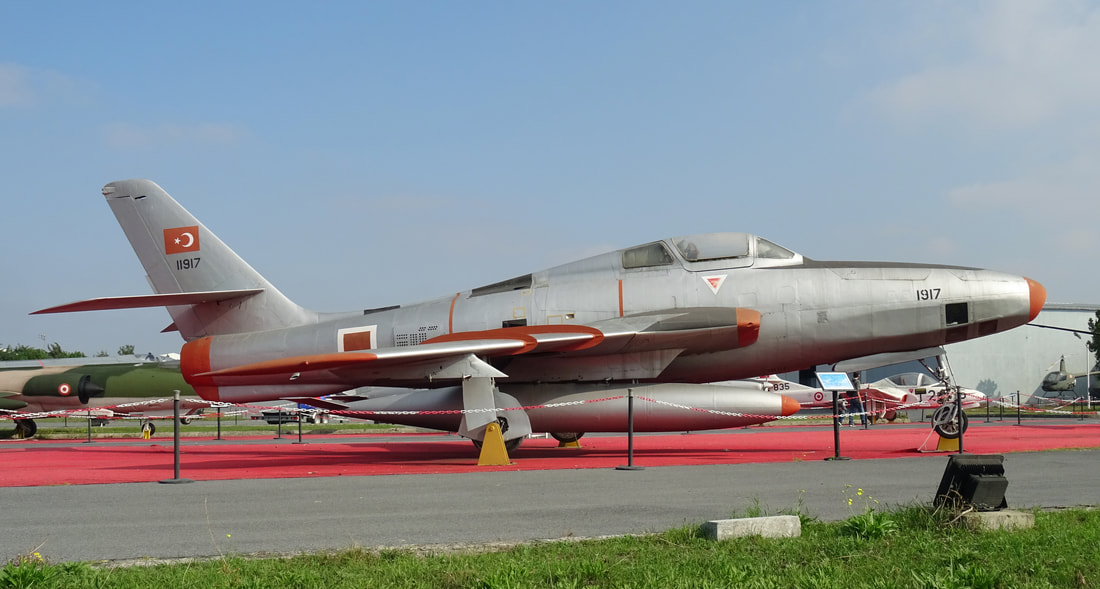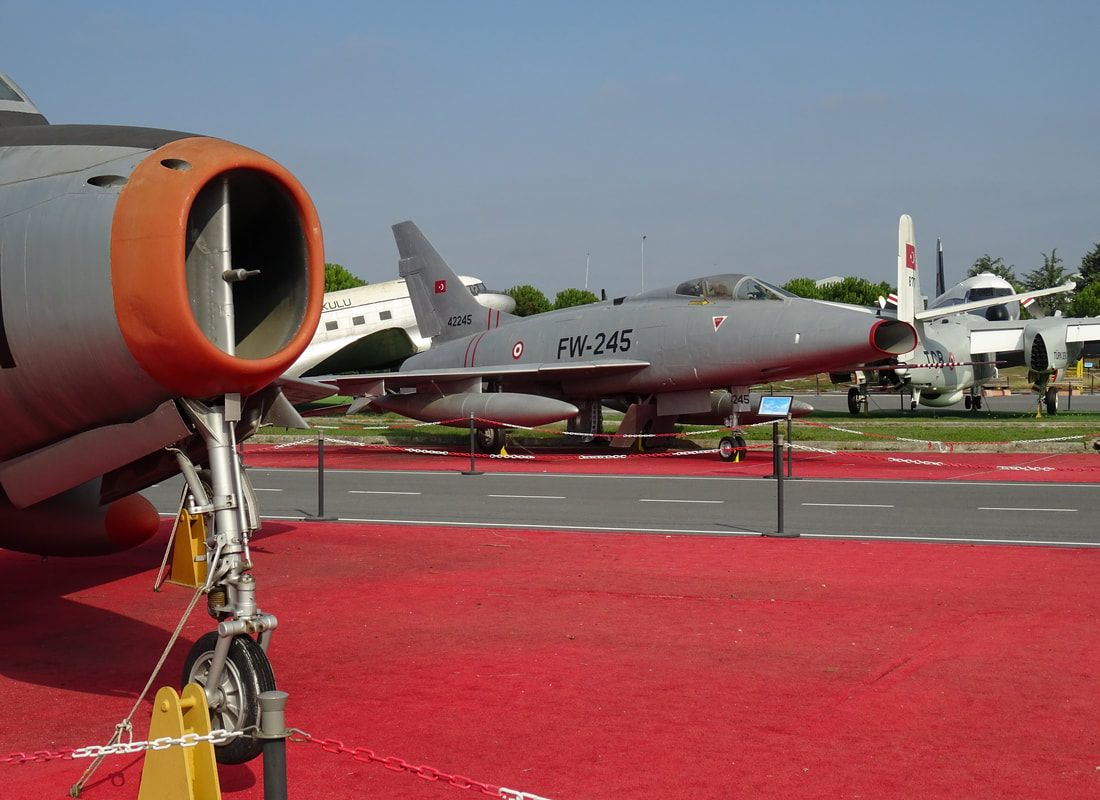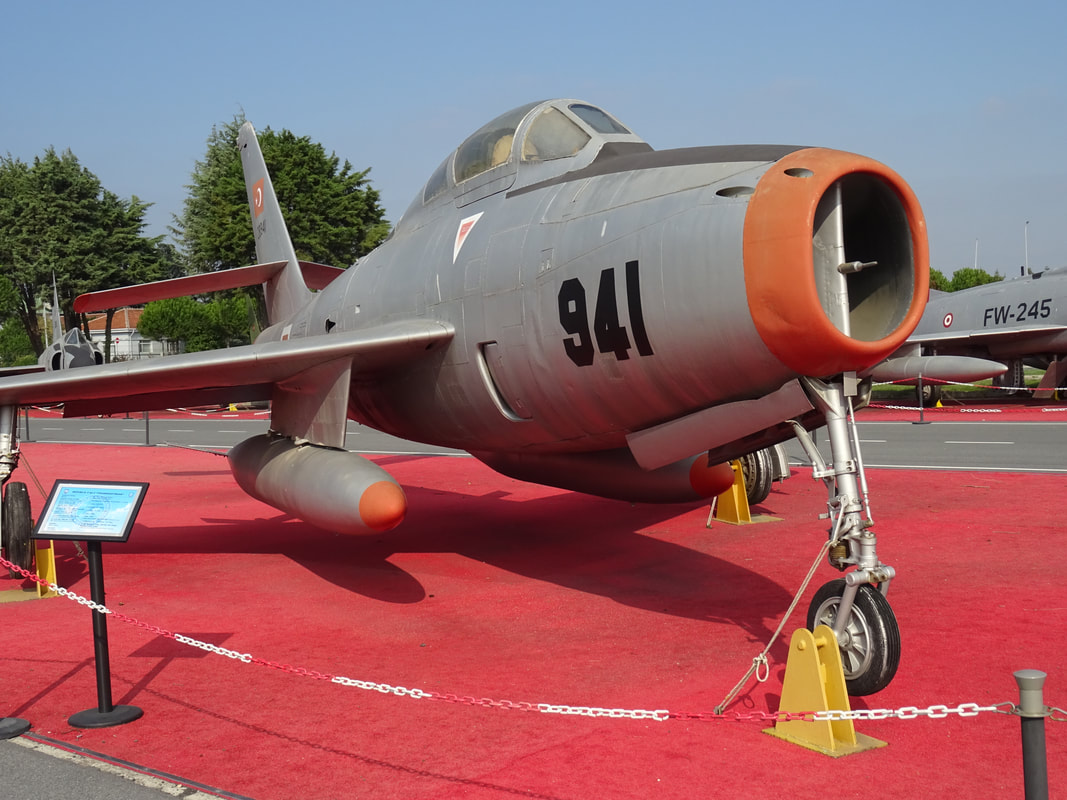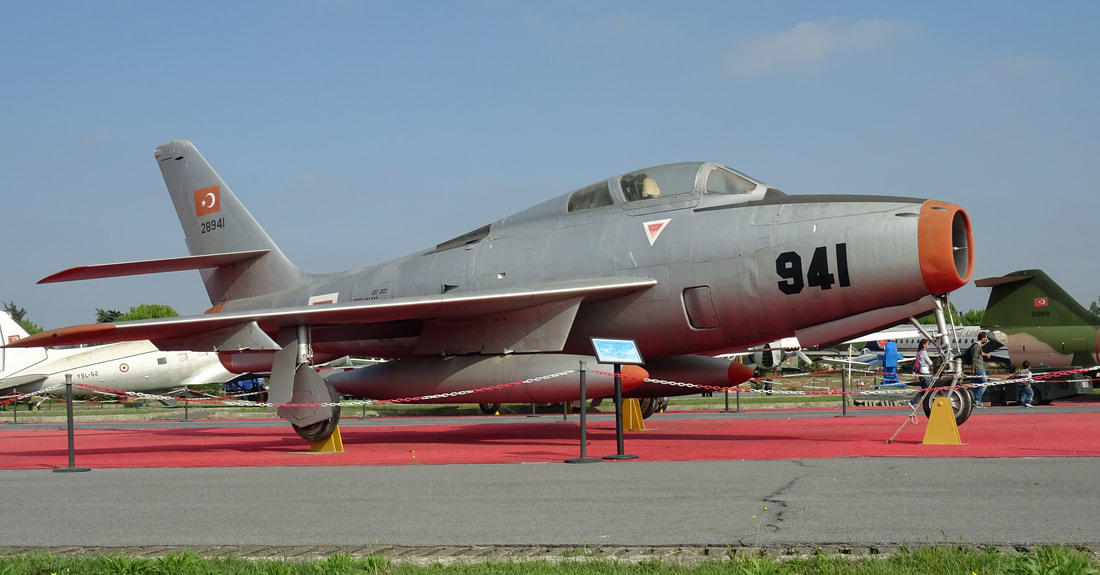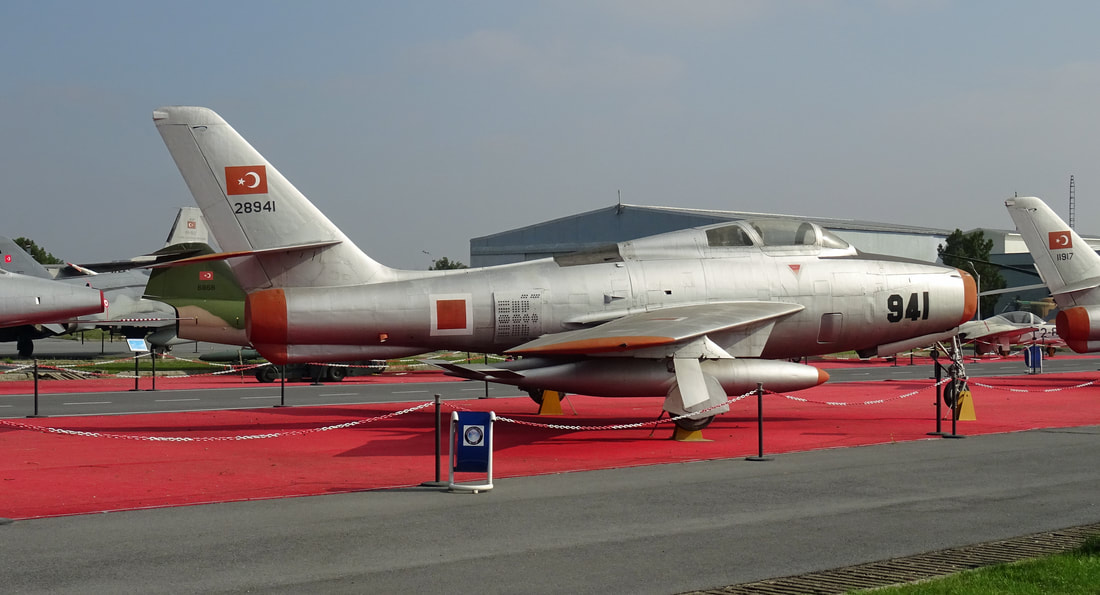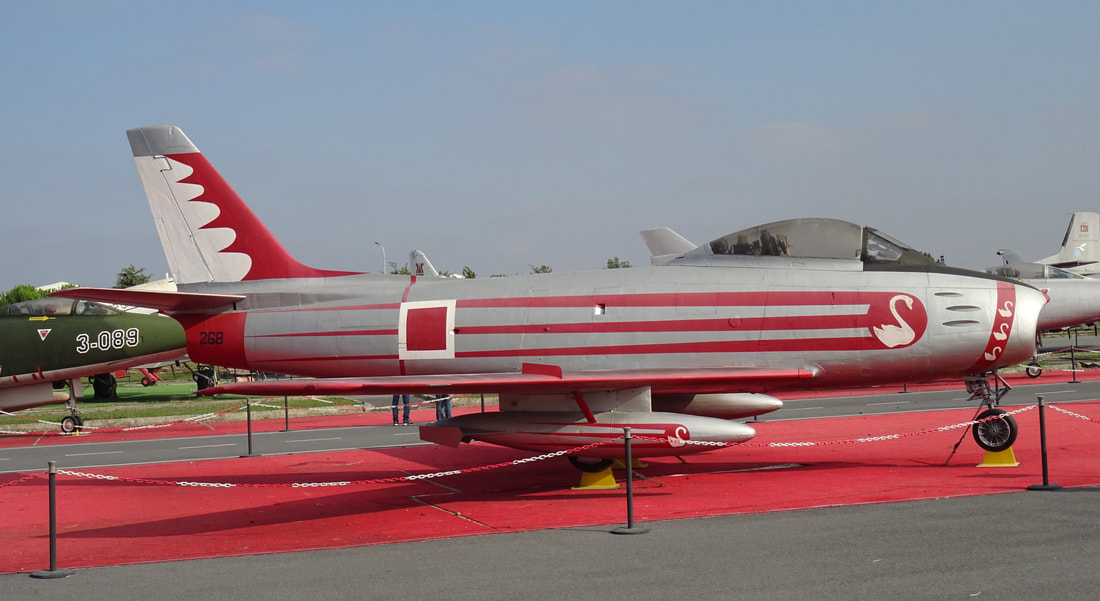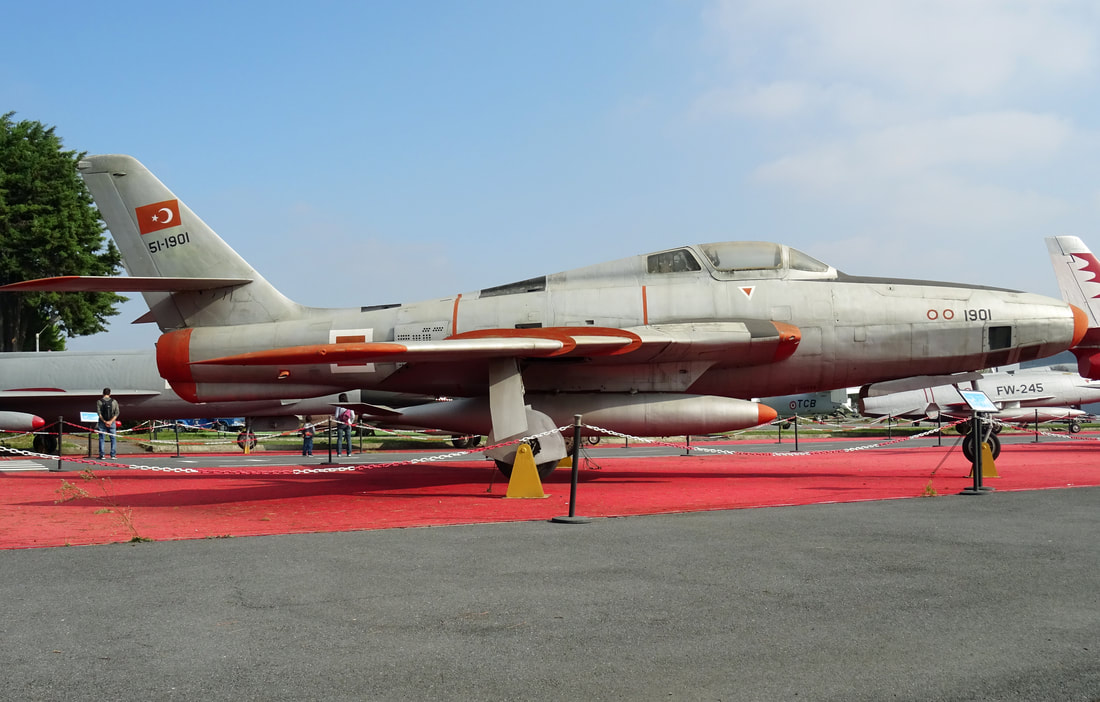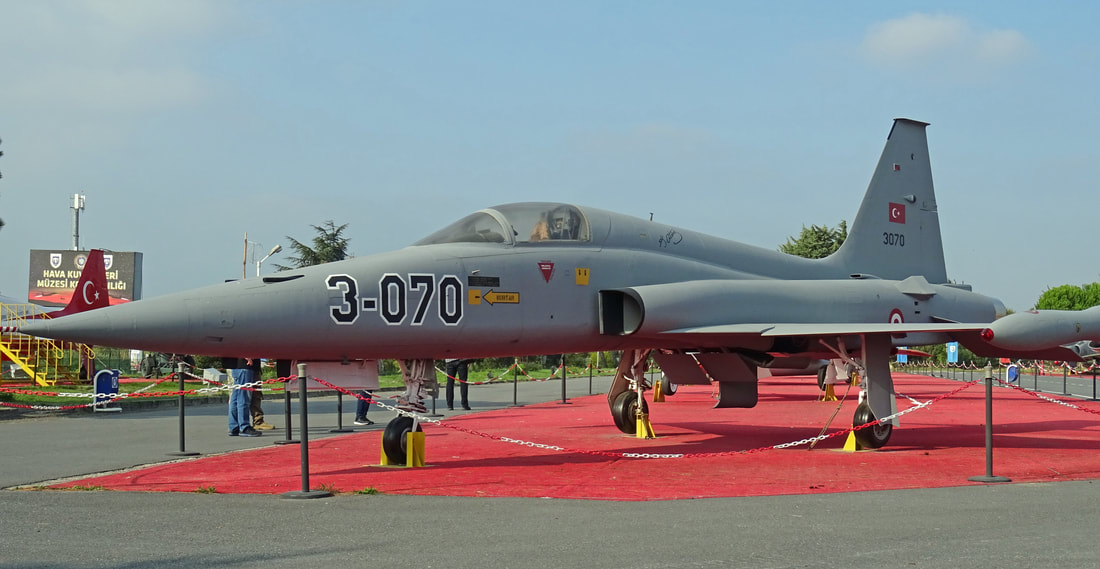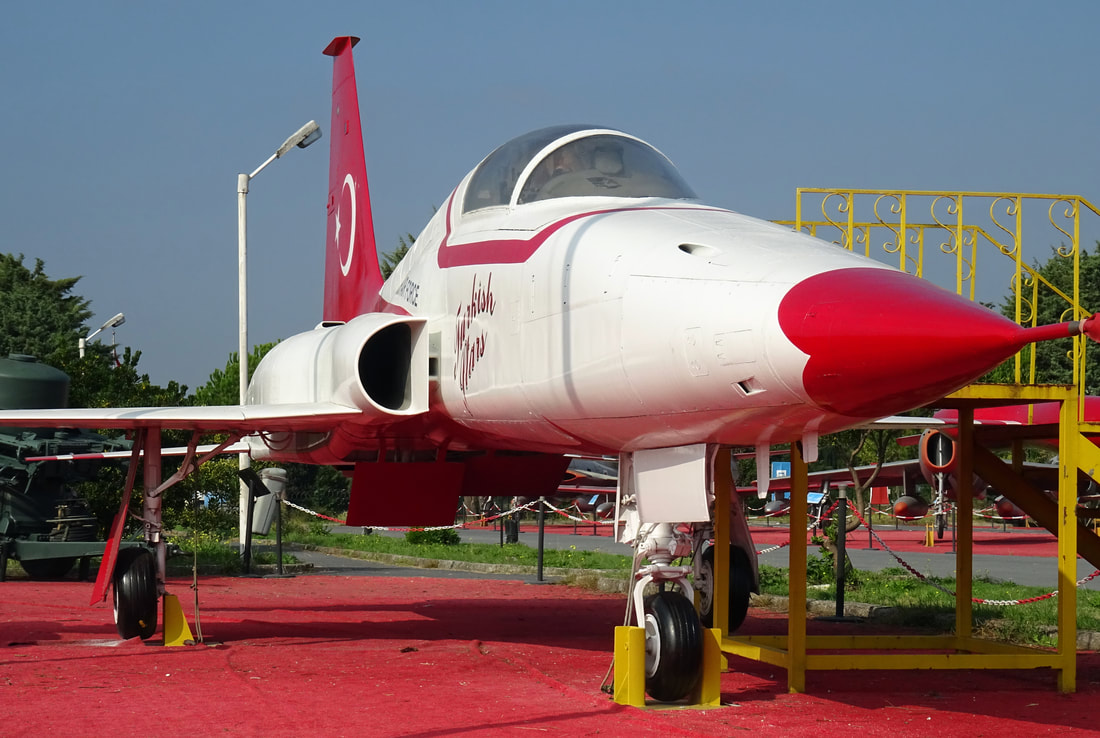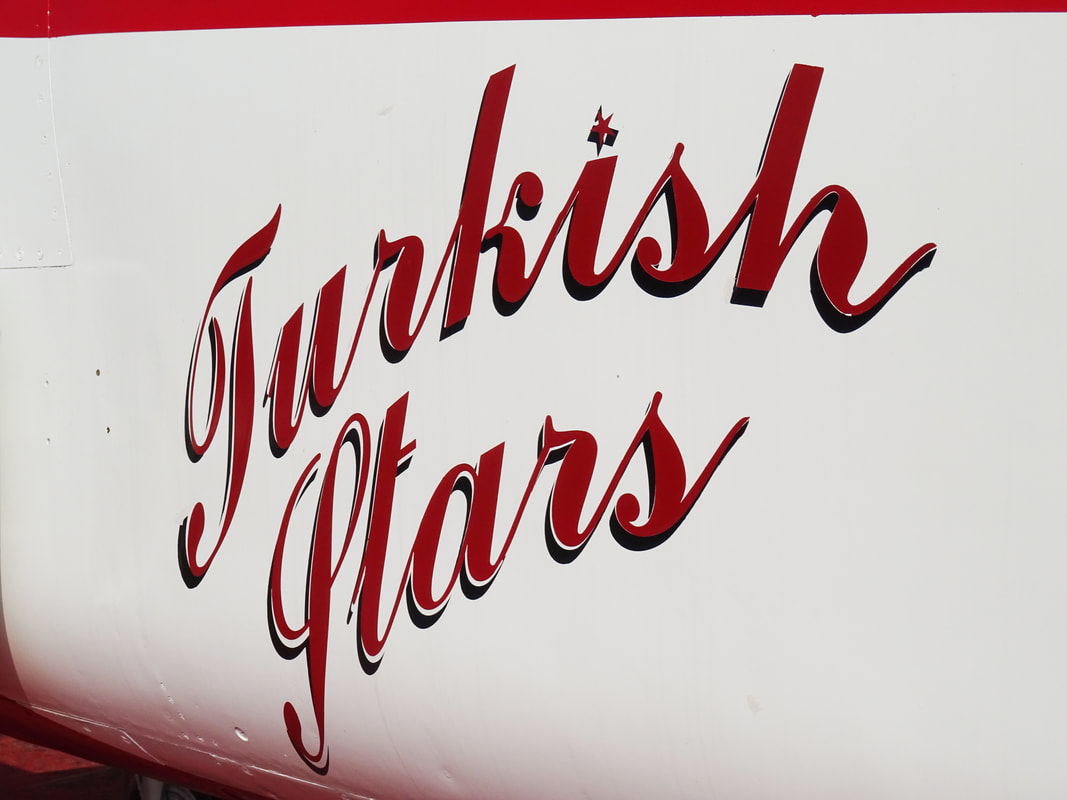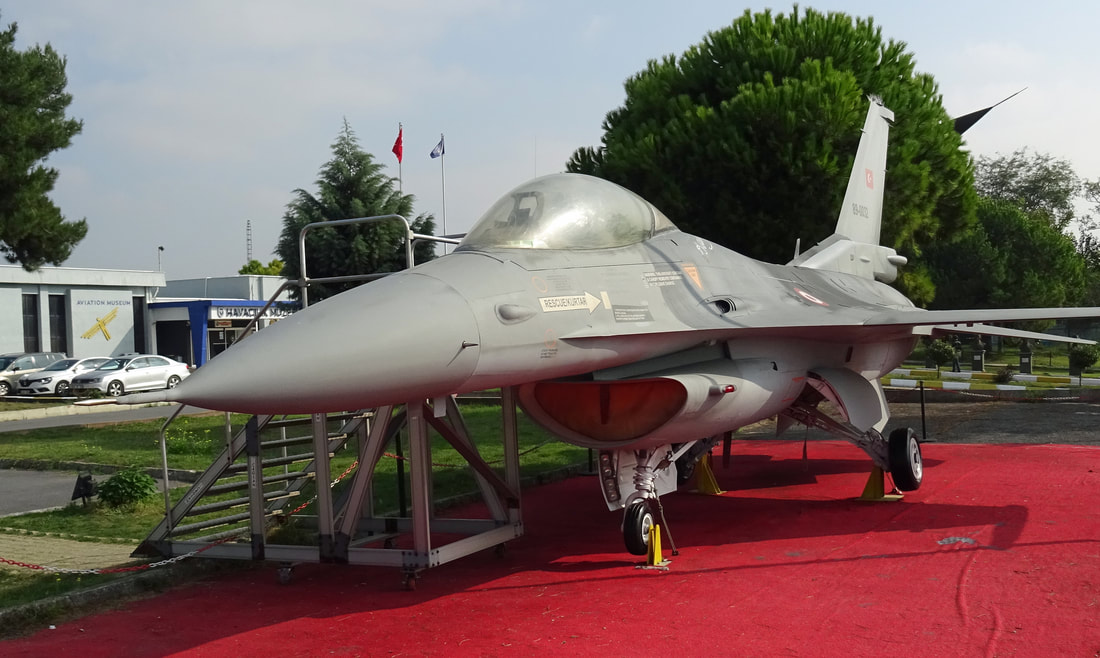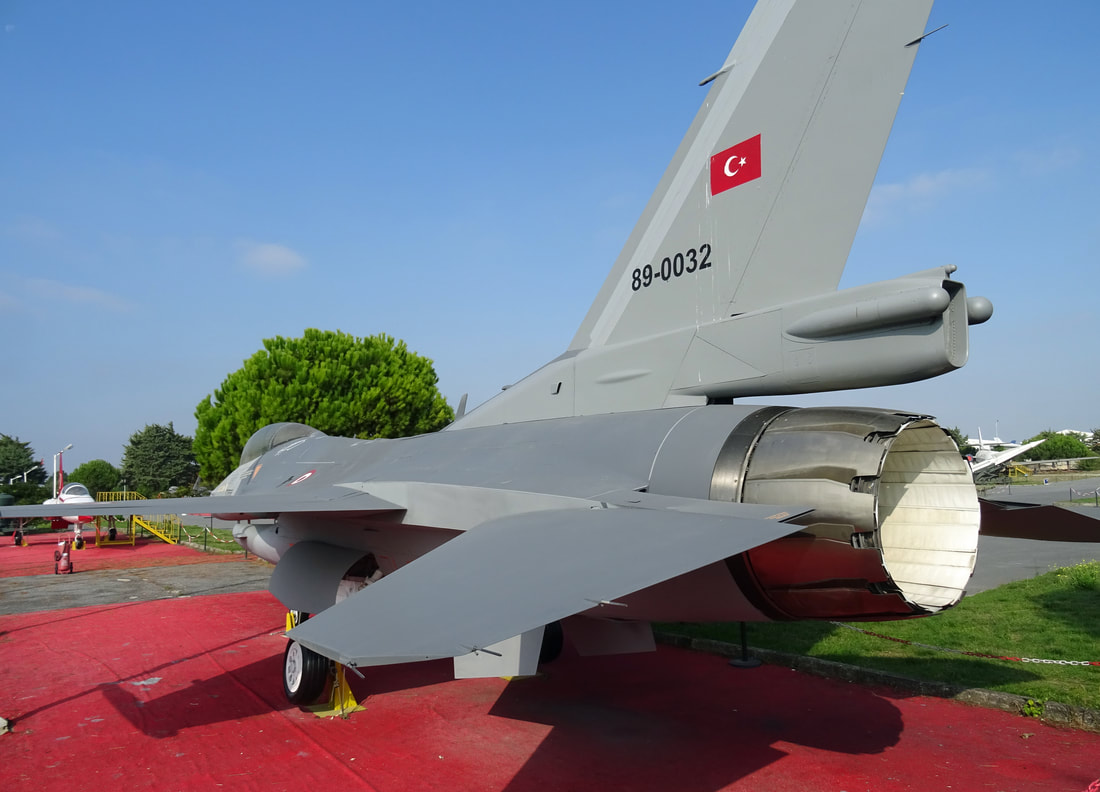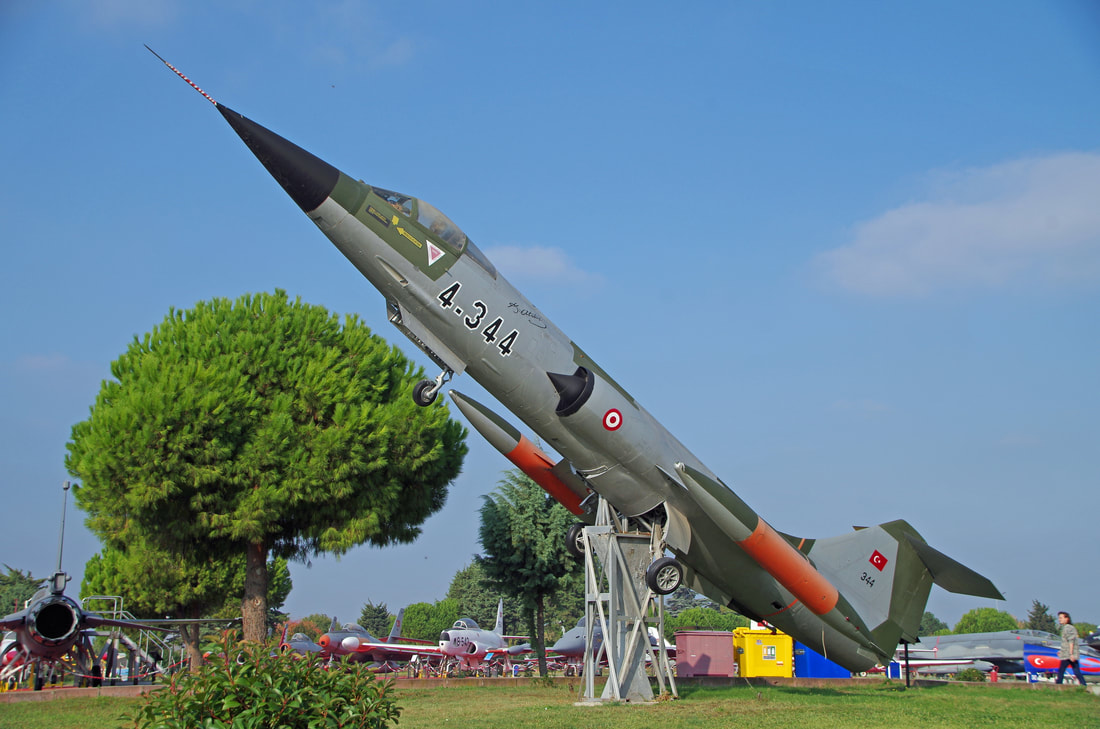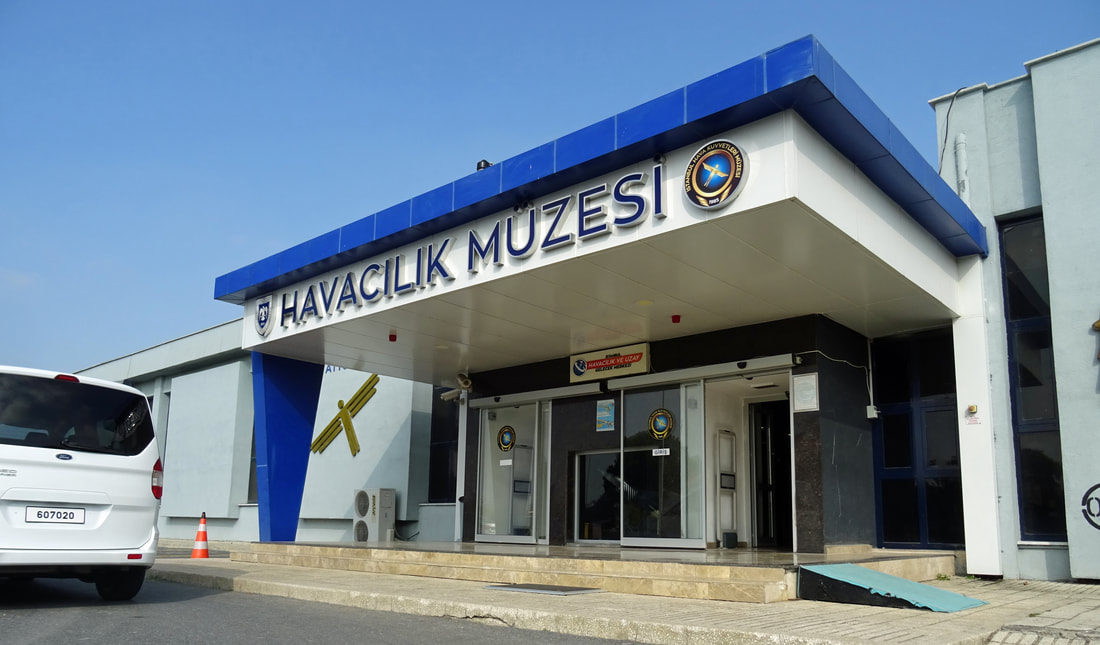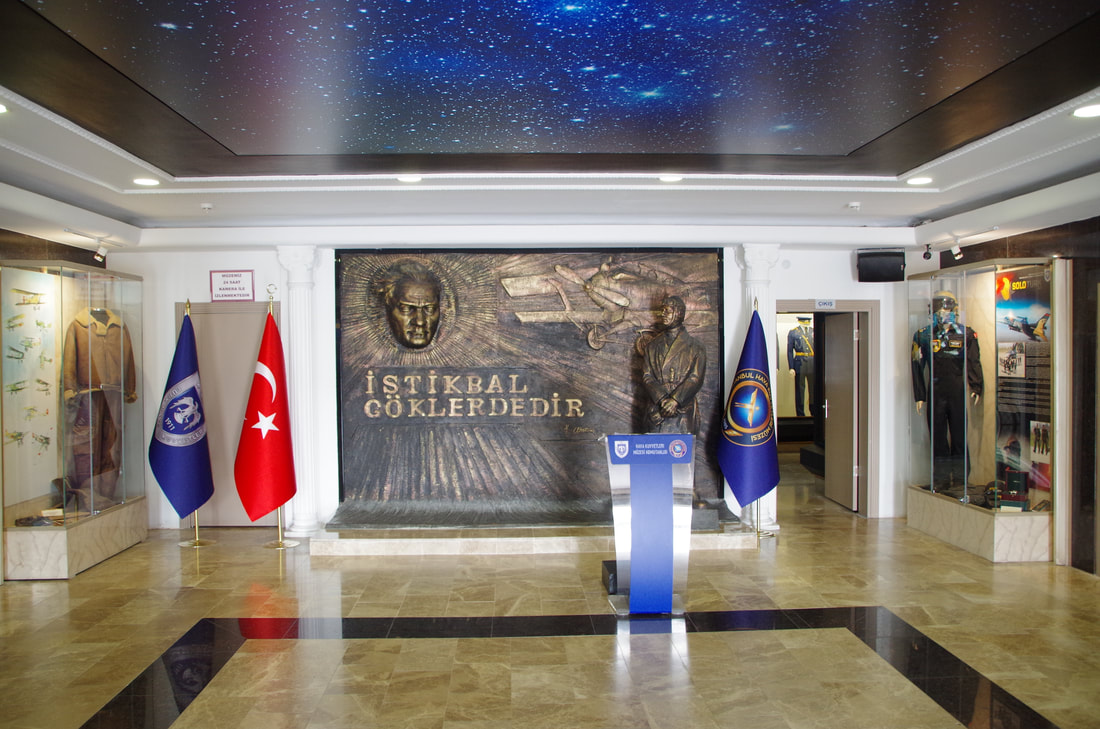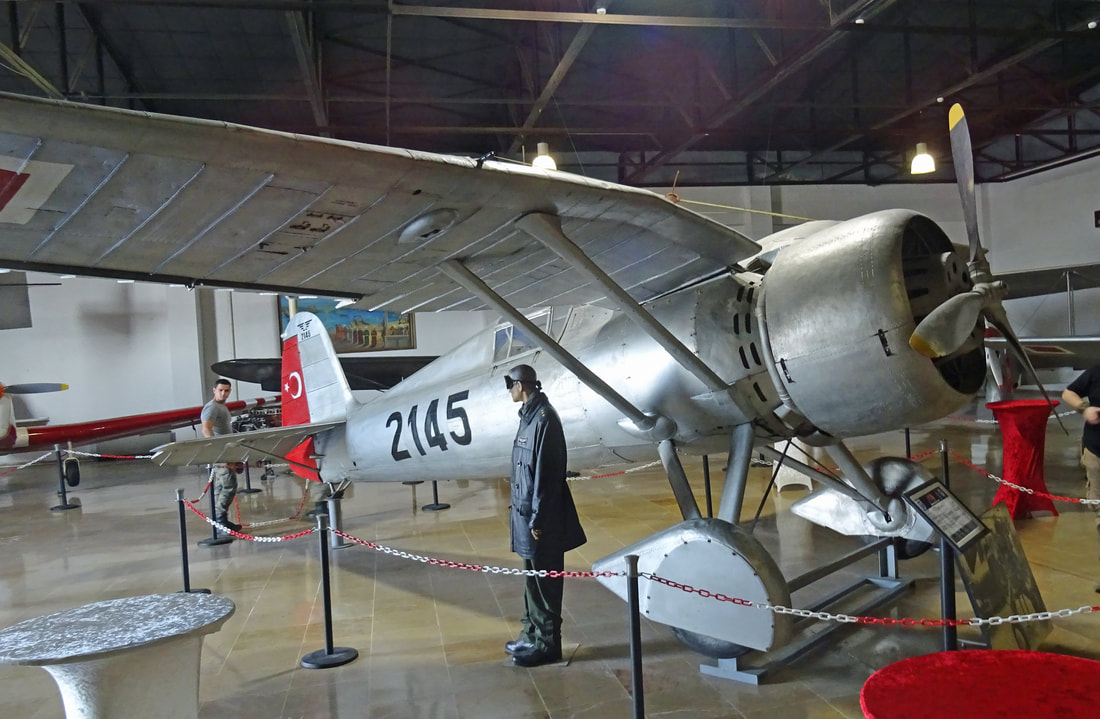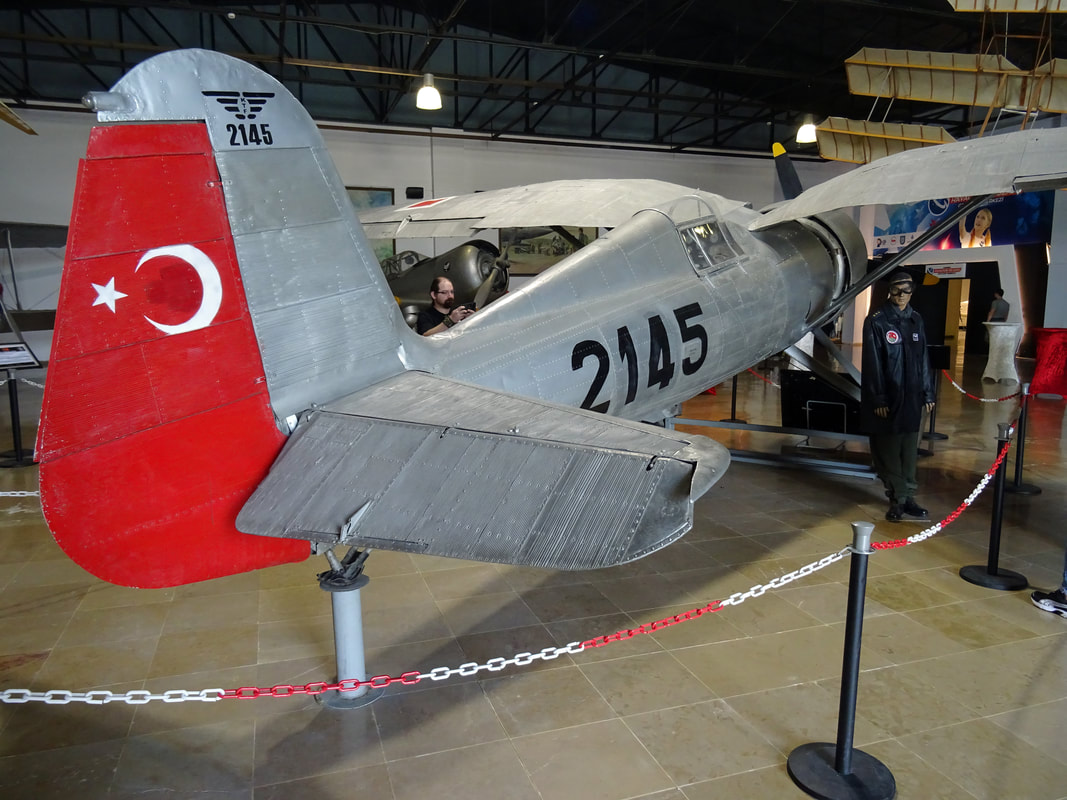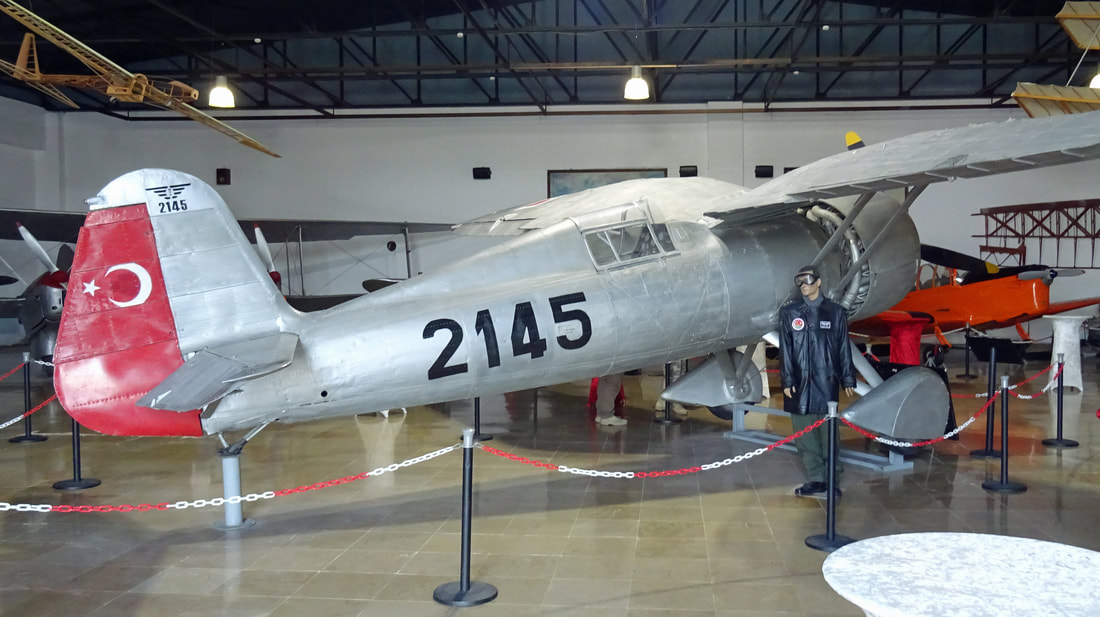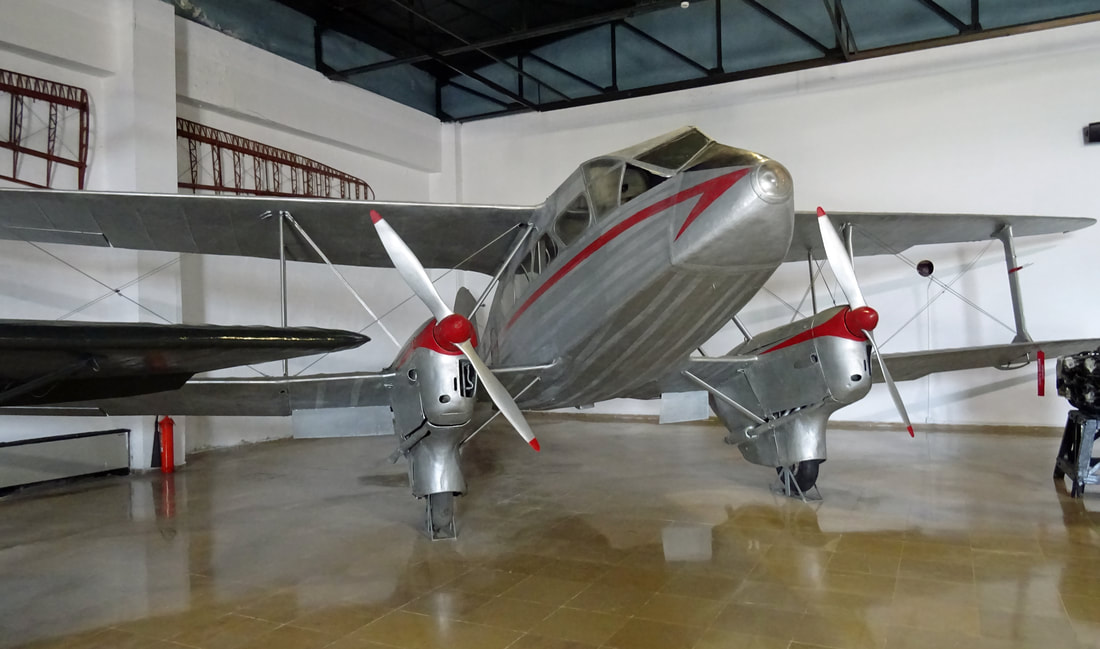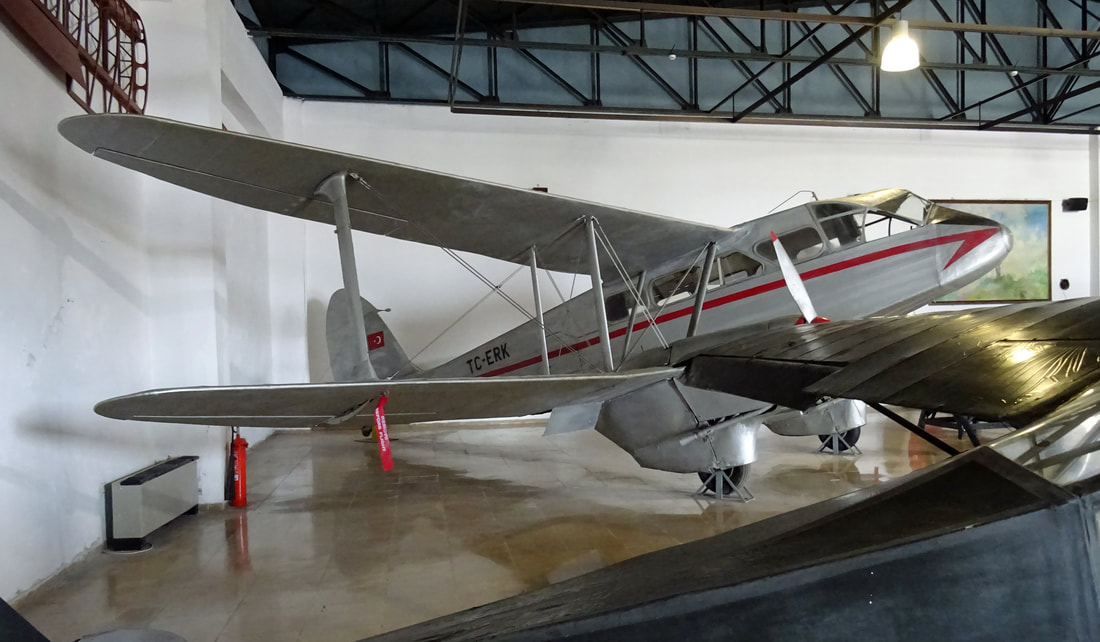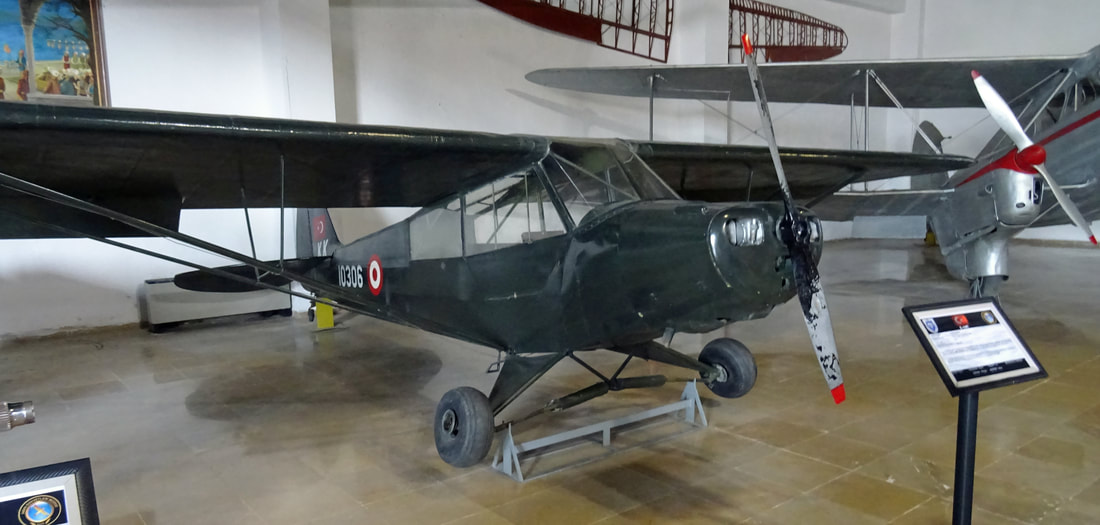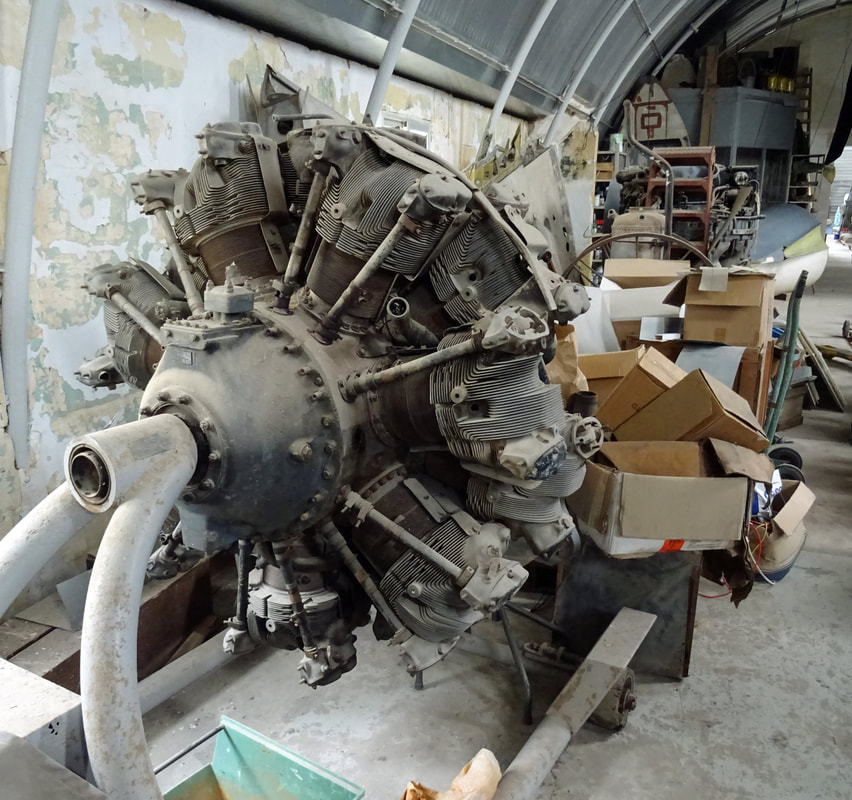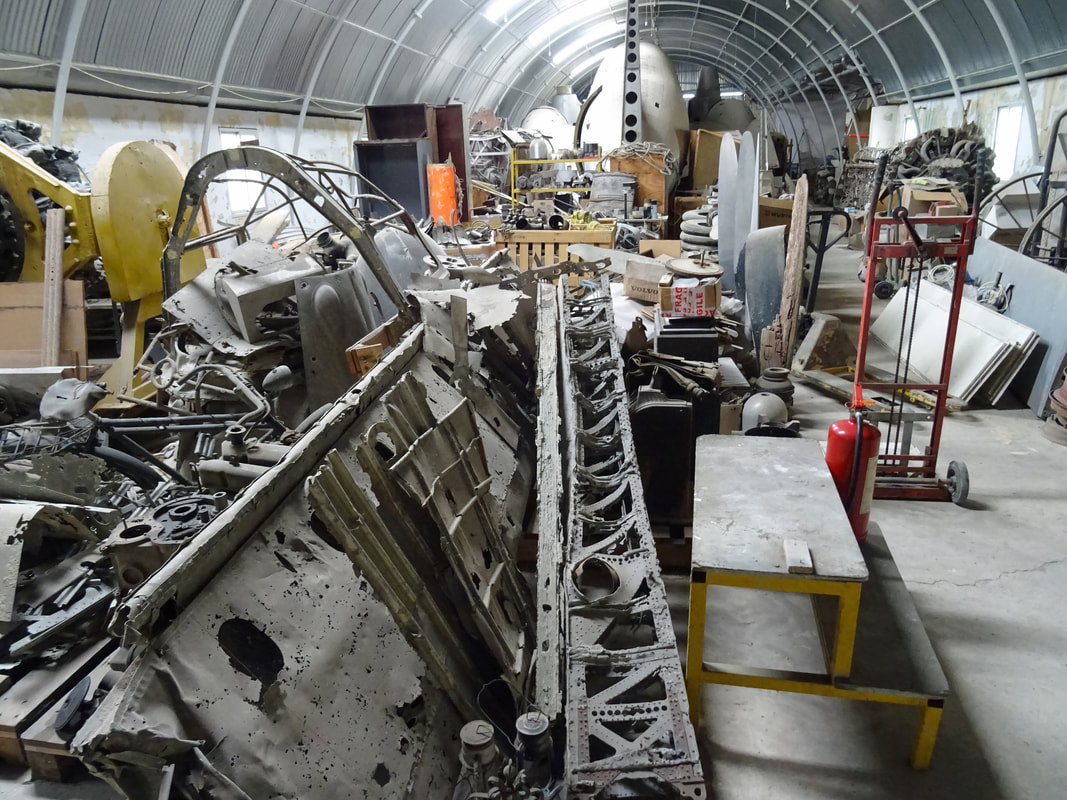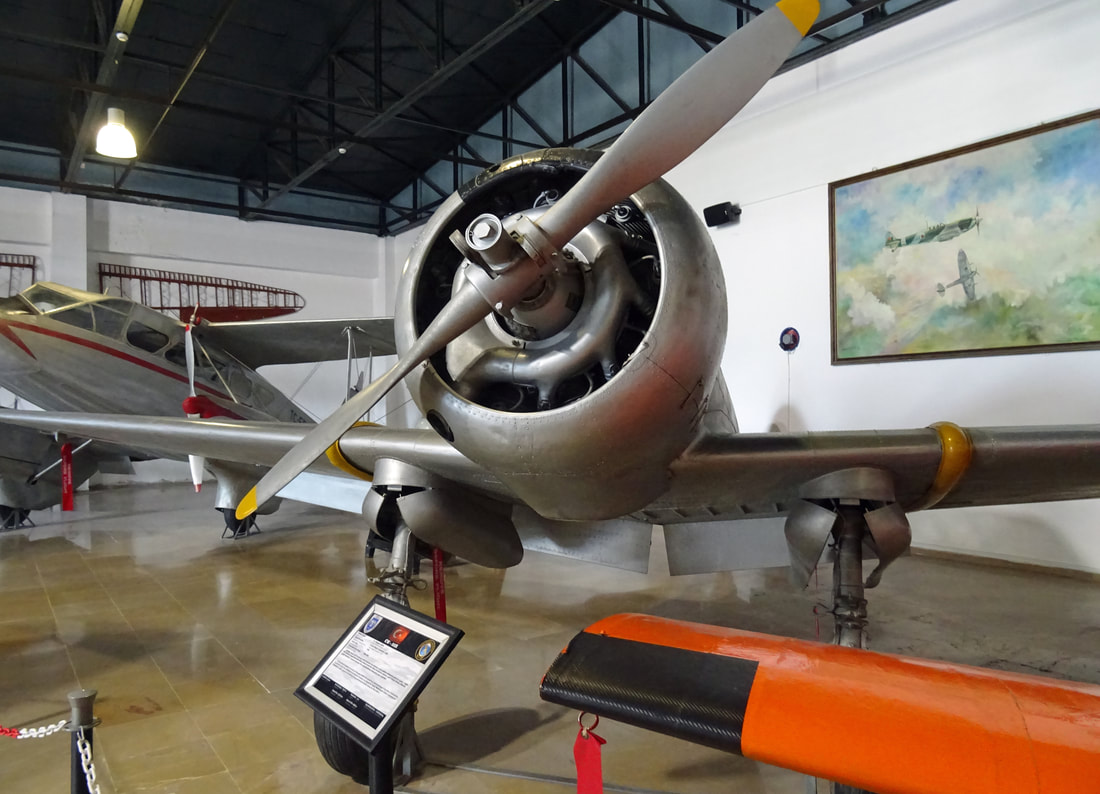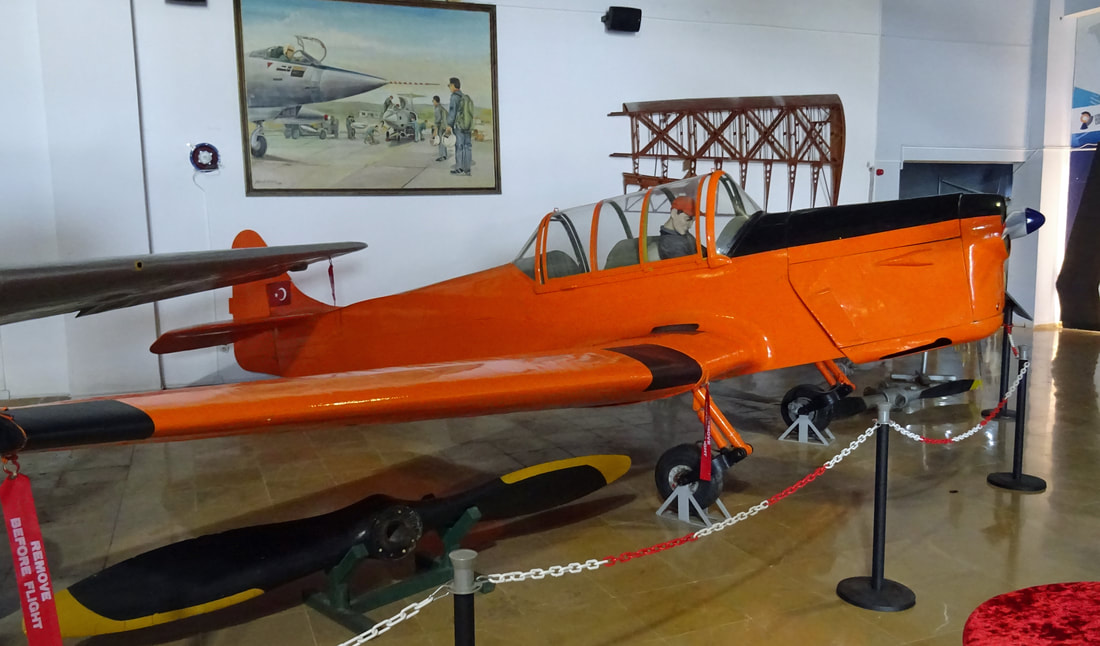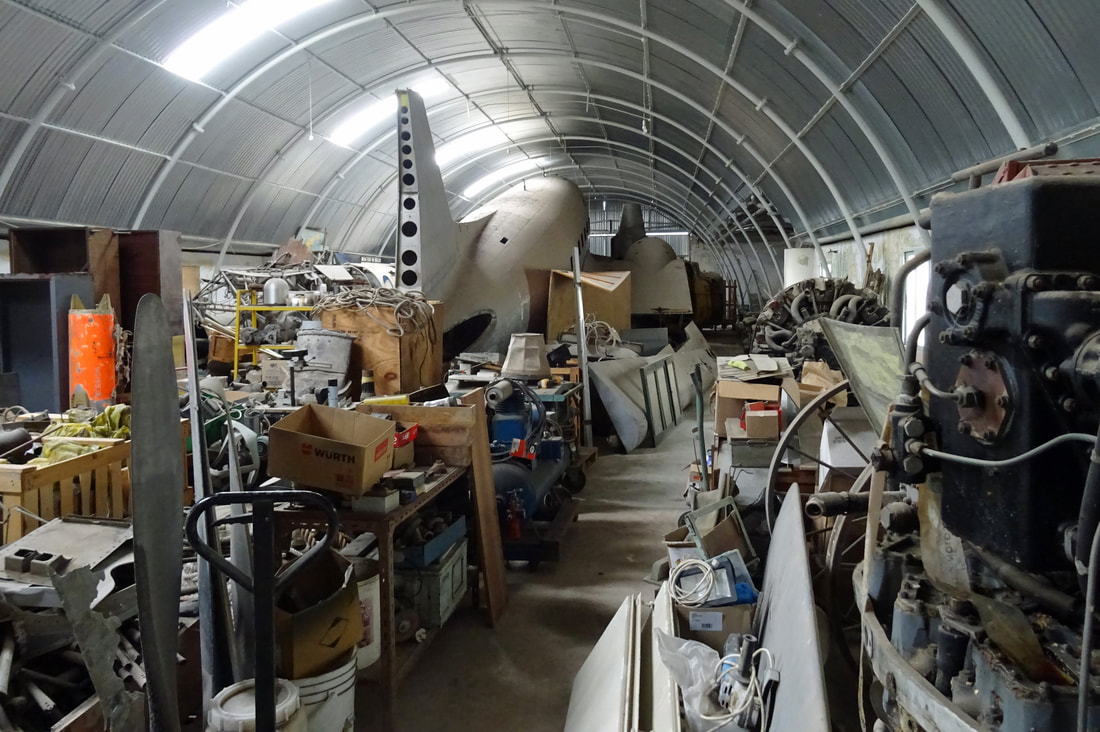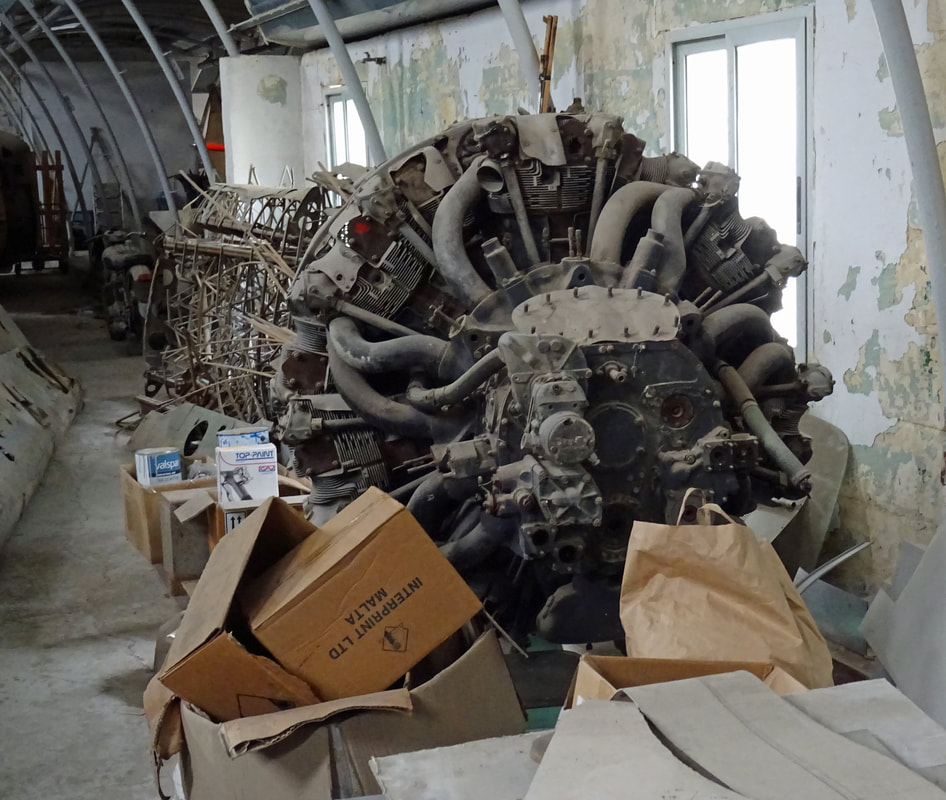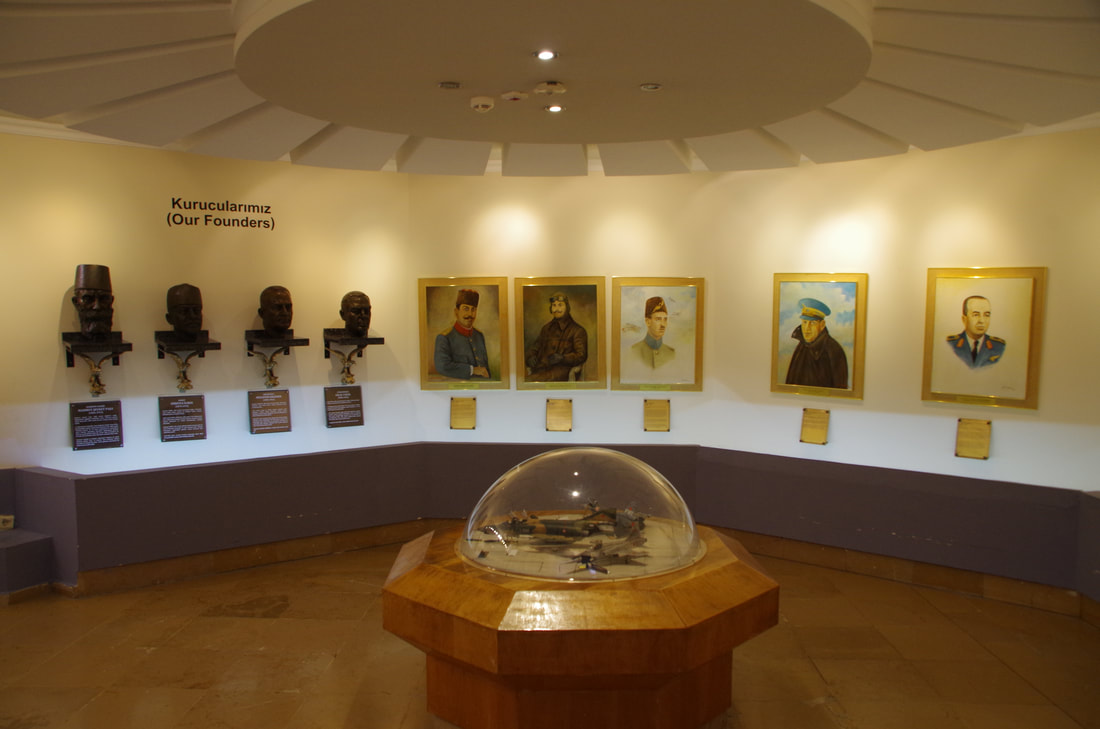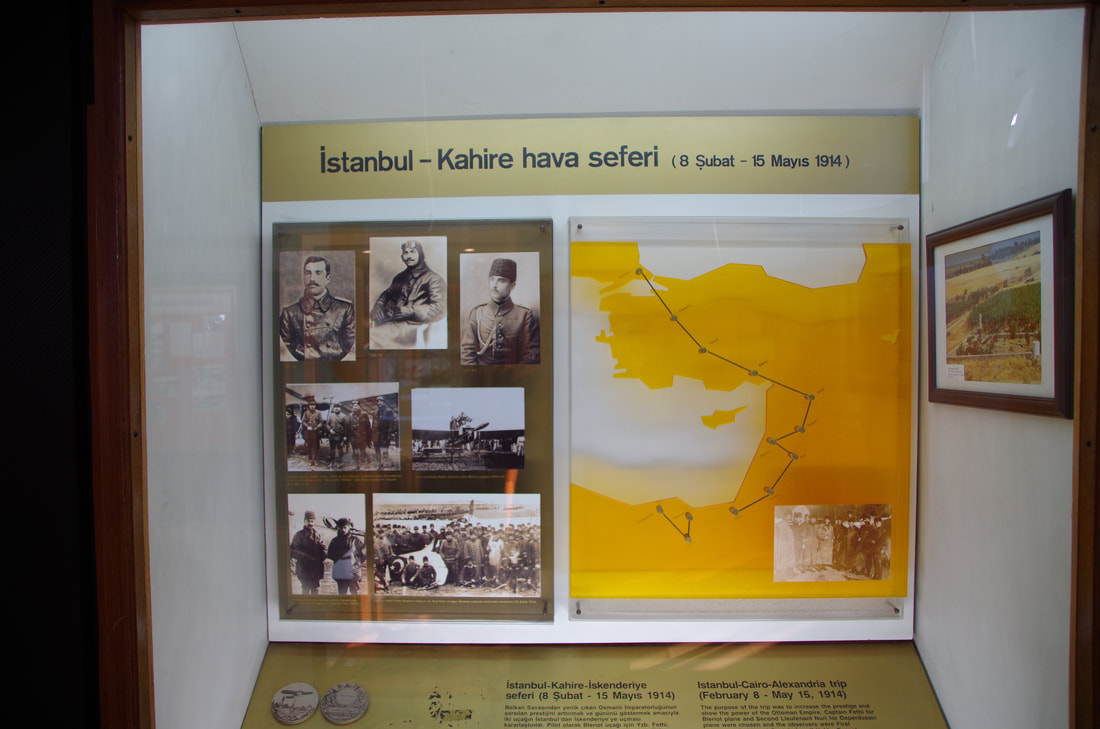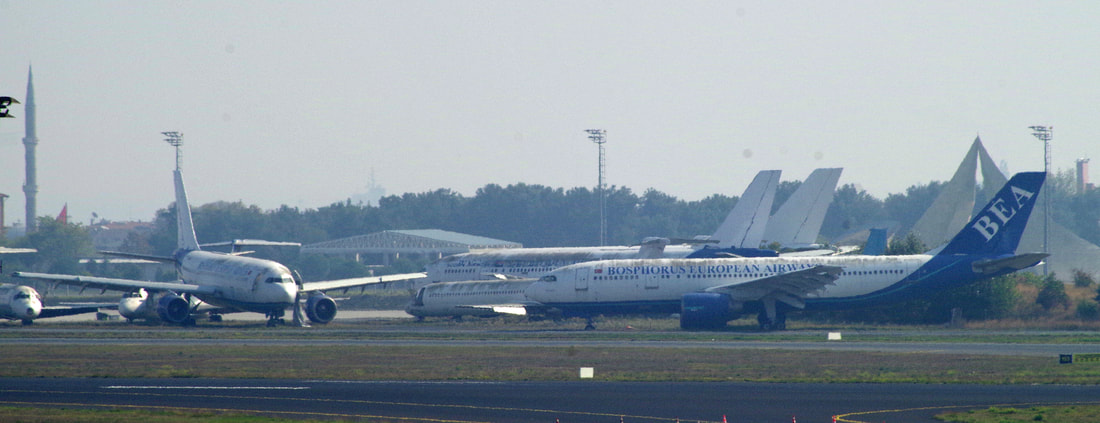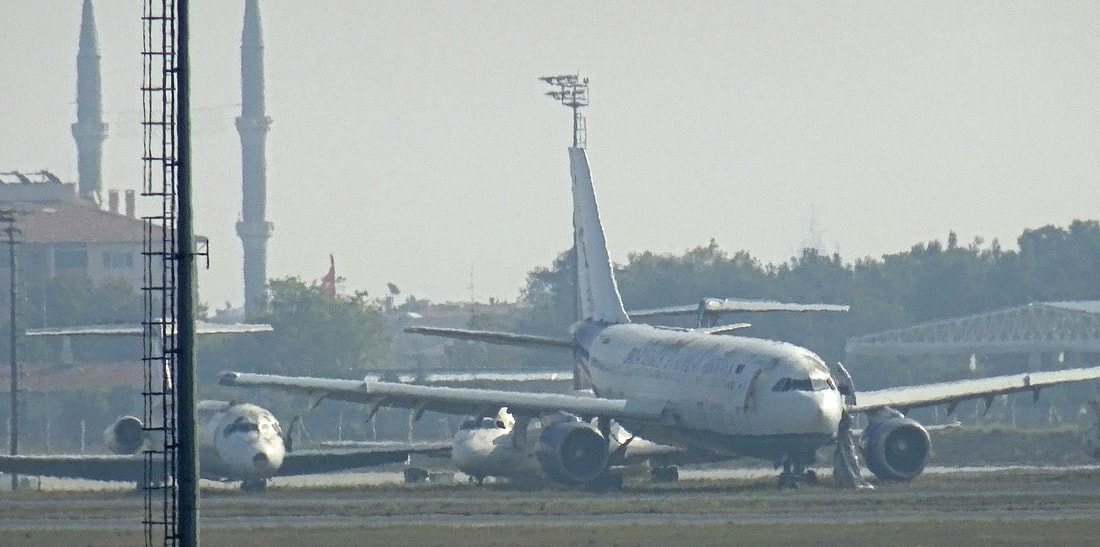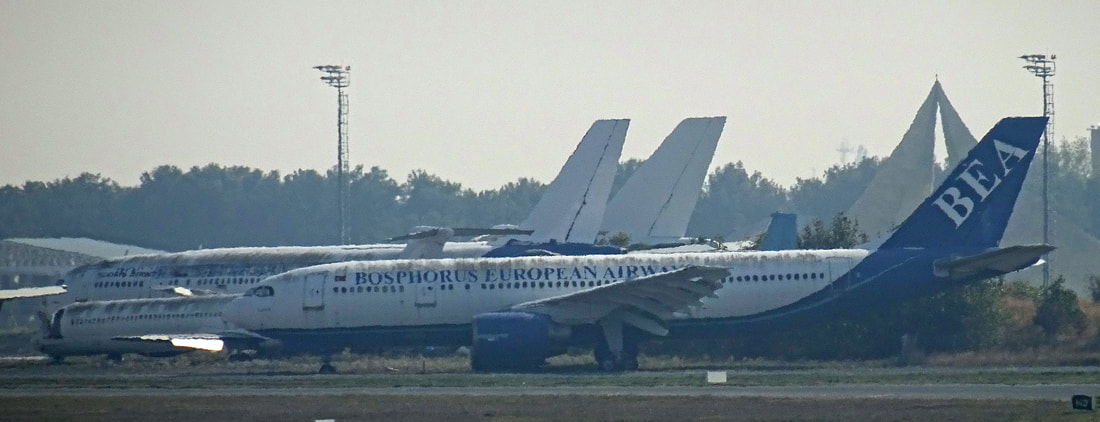Havacilik Muzesi, Yesilkoy, Istanbul
The Turkish Aviation museum re-visited in 2019
by Jan Koppen
This fine machine has been preserved at the Istanbul Aviation museum since the mid-1990.
|
The Turkish Aviation Museum in Istanbul
During October 2019, I re-visited the astonishing Turkish Aviation museum. The Istanbul Aviation Museum, a.k.a. Turkish Air Force Museum, (Turkish: Havacılık Müzesi or Hava Kuvvetleri Müzesi) is a military-based museum for aviation, owned and operated by the Turkish Air Force. The museum is located in Yeşilköy neighborhood of Bakırköy district in Istanbul, Turkey. The museum not only presents various warplanes, helicopters and weapons used by the Turkish Air Force, but also civilian air transport and many samples of Turkish aeronautics history, starting from the Ottoman era. |
The Caravelle stands outside for over 25 years at Istanbul Aviation Musuem. Dirt has gathered
in all the panel lines showing most clearly around the nose and engine cowlings.
in all the panel lines showing most clearly around the nose and engine cowlings.
|
Built in 1968, c/n. 253 was delivered new to SATA – S.A. de Transport Aerien in Switserland with registration HB-ICN. 10 years later she served CTA – Compagnie de Transport Aerien under the same registration. After serving CTA she was sold again went on to serve Istanbul Airlines in 1988 as TC-ABA. She was retired from service and donated to the Istanbul Aviation museum in August 1993.
|
An airplane stored outside will be subject to streaking down the paintwork from dust and dirt deposits unless washed regularly.
|
The Vickers Viscount is a British medium-range turboprop airliner first flown in 1948 by Vickers-Armstrongs. A design requirement from the Brabazon Committee, it entered service in 1953 and was the first turboprop-powered airliner.
The Viscount was well received by the public for its cabin conditions, which included pressurisation, reductions in vibration and noise, and panoramic windows. It became one of the most successful and profitable of the first post-war transport aircraft; 445 Viscounts were built for a range of international customers, including in North America. |
Airframe 10788 was manufactured 1945 and delivered that same year to USAF as 42-72683. During the years this C-54D-10-DC Skymaster was exported to Turkey for service in the Turkish Air Force as ETI-683. In 1997 she went on display at the Turkish Air Force Museum in Yesilkoy.
|
The Douglas C-54 Skymaster is a four-engined transport aircraft used by the United States Army Air Forces in World War II and the Korean War. Like the Douglas C-47 Skytrain derived from the DC-3, the C-54 Skymaster was derived from a civilian airliner, the Douglas DC-4. Besides transport of cargo, the C-54 also carried presidents, prime ministers, and military staff. Dozens of variants of the C-54 were employed in a wide variety of non-combat roles such as air-sea rescue, scientific and military research, and missile tracking and recovery. During the Berlin Airlift it hauled coal and food supplies to West Berlin. After the Korean War it continued to be used for military and civilian uses by more than 30 countries. It was one of the first aircraft to carry the President of the United States.
|
Beautiful shape even in green/brown drab this once pristine preserved example
of the most elegant airliner built, sadly shows advanced signs of decay.
of the most elegant airliner built, sadly shows advanced signs of decay.
|
H-008 built as a C-47B-10-DK model with (c/n. 15011/26456) Delivered in November 1944 to the USAF as 43-49195. Went to the Turkish air force as 43-6008 during November 1946 Noted with drawn from use during September 1985 and was put up as display during 1989
(6008)/H-008 Douglas C-47B Skytrain (15011/26456) at the Havacılık Müzesi, Istanbul-Yeşilköy |
The Sikorsky H-19 Chickasaw (company model number S-55) was a multi-purpose helicopter used by the United States Army and United States Air Force. It was also license-built by Westland Aircraft as the Westland Whirlwindin the United Kingdom. United States Navy and United States Coast Guard models were designated HO4S, while those of the U.S. Marine Corps were designated HRS. In 1962, the U.S. Navy, U.S. Coast Guard and U.S. Marine Corps versions were all redesignated as H-19s like their U.S. Army and U.S. Air Force counterparts.
69-022/022 Aerospatiale C-160D Transall (D22) at the Havacılık Müzesi, Istanbul-Yeşilköy on October 27, 2019.
|
The Transall C-160 is a military transport aircraft, produced as a joint venture between France and Germany. "Transall" is an abbreviation of the manufacturing consortium Transporter Allianz, comprising the companies of MBB, Aerospatiale and VFW-Fokker. It was initially developed to meet the requirements for a modern transport aircraft for the French and German Air Forces; export sales were also made to South Africa and to Turkey, as well as a small number to civilian operators.
The C-160 remained in service more than 50 years after the type's first flight in 1963. It has provided logistical support to overseas operations and has served in specialist roles such as an aerial refueling tanker, electronic intelligence gathering and as a communications platform. The C-160 is expected to be replaced in French and German service by the Airbus A400M Atlas. |
Turkish Air Force Beech AT-11 Kansan still manages to look majestic despite her age.
|
The Beechcraft Model 18 (or "Twin Beech", as it is also known) is a 6- to 11-seat, twin-engined, low-wing, tailwheel light aircraft manufactured by the Beech Aircraft Corporation of Wichita, Kansas. Continuously produced from 1937 to November 1969 (over 32 years, a world record at the time), over 9,000 were built, making it one of the world's most widely used light aircraft. Sold worldwide as a civilian executive, utility, cargo aircraft, and passenger airliner on tailwheels, nosewheels, skis, or floats, it was also used as a military aircraft.
During and after World War II, over 4,500 Beech 18s were used in military service—as light transport, light bomber (for China), aircrew trainer (for bombing, navigation, and gunnery), photo-reconnaissance, and "mother ship" for target drones—including United States Army Air Forces (USAAF) C-45 Expeditor, AT-7 Navigator, and AT-11 Kansan; and United States Navy (USN) UC-45J Navigator, SNB-1 Kansan, and others. In World War II, over 90% of USAAF bombardiers and navigators trained in these aircraft. |
The Dornier Do-27 was a German single-engine STOL utility aircraft, manufactured by Dornier GmbH (later DASA
Dornier, Fairchild-Dornier). Configuration was a classic high-wing, "tail-dragger" aircraft with fixed landing gear.
Dornier, Fairchild-Dornier). Configuration was a classic high-wing, "tail-dragger" aircraft with fixed landing gear.
|
The type designation Dornier Do-28 comprises two different twin-engine STOL utility aircraft, manufactured by Dornier Flugzeugbau GmbH. Most of them served with the German Air Force and Marineflieger and other air forces around the world in the communications and utility role. The Do 28 series consists of the fundamentally different Do 28 A/B (1959) and Do 28 D Skyservant (1966).
|
|
The Dornier Do 27 was a German single-engine STOL utility aircraft, manufactured by Dornier GmbH (later DASADornier, Fairchild-Dornier). Configuration was a classic high-wing, "tail-dragger" aircraft with fixed landing gear. |
The Piper PA-18 Super Cub is a two-seat, single-engine monoplane. Introduced in 1949 by Piper Aircraft, it was developed from the Piper PA-11, and traces its lineage back through the J-3 to the Taylor E-2 Cub of the 1930s. In close to 40 years of production, over 9,000 were built. Super Cubs are commonly found in roles such as bush flying, banner towing and glider towing.
Military designation of the PA-18 Super Cub for the United States Army, powered by a 95 hp (71 kW) Continental C90-8F piston engine, 838 delivered, at least 156 of which were delivered to other nations under MDAP.
The Cessna 185 Skywagon is a six-seat, single-engined, general aviation light aircraft manufactured by Cessna. It first flew as a prototype in July 1960, with the first production model completed in March 1961. The Cessna 185 is a high-winged aircraft with non-retractable conventional landing gear and a tailwheel.
Over 4,400 were built with production ceasing in 1985. When Cessna re-introduced some of its most popular models in the 1990s, the tailwheel equipped Cessna 180 and 185 were not put back into production.
Over 4,400 were built with production ceasing in 1985. When Cessna re-introduced some of its most popular models in the 1990s, the tailwheel equipped Cessna 180 and 185 were not put back into production.
The Grumman S-2 Tracker (S2F prior to 1962) was the first purpose-built, single airframe anti-submarine warfare(ASW) aircraft to enter service with the United States Navy. Designed and initially built by Grumman, the Tracker was of conventional design — propeller-driven with twin radial engines, a high wing that could be folded for storage on aircraft carriers, and tricycle undercarriage. The type was exported to a number of navies around the world. Introduced in 1952, the Tracker and its E-1 Tracer derivative saw service in the U.S. Navy until the mid-1970s, and its C-1 Trader derivative until the mid-1980s, with a few aircraft remaining in service with other air arms into the 21st century. Argentina and Brazil are the last countries to still use the Tracker.
The McDonnell Douglas F-4 Phantom II is a tandem two-seat, twin-engine, all-weather, long-range supersonic jet interceptor and fighter-bomber originally developed for the United States Navy by McDonnell Aircraft. It first entered service in 1960 with the Navy. Proving highly adaptable, it was also adopted by the United States Marine Corps and the United States Air Force, and by the mid-1960s had become a major part of their air arms.
|
The Turkish Air Force (TAF) received 40 F-4Es in 1974, with a further 32 F-4Es and 8 RF-4Es in 1977–78 under the "Peace Diamond III" program, followed by 40 ex-USAF aircraft in "Peace Diamond IV" in 1987, and a further 40 ex-U.S. Air National Guard Aircraft in 1991. A further 32 RF-4Es were transferred to Turkey after being retired by the Luftwaffe between 1992 and 1994. In 1995, Israel Aerospace Industries (IAI) implemented an upgrade similar to Kurnass 2000 on 54 Turkish F-4Es which were dubbed the F-4E 2020 Terminator. Turkish F-4s, and more modern F-16s have been used to strike Kurdish PKK bases in ongoing military operations in Northern Iraq. |
|
The Bell UH-1 Iroquois (nicknamed "Huey") is a utility military helicopter powered by a single turboshaft engine, with two-blade main and tail rotors. The first member of the prolific Huey family, it was developed by Bell Helicopterto meet a United States Army's 1952 requirement for a medical evacuation and utility helicopter, and first flew in 1956. The UH-1 was the first turbine-powered helicopter produced for the United States military, and more than 16,000 have been built since 1960.
The Iroquois was originally designated HU-1, hence the Huey nickname, which has remained in common use, despite the official redesignation to UH-1 in 1962. The UH-1 first saw service in combat operations during the Vietnam War, with around 7,000 helicopters deployed. The Bell 204 and 205 are Iroquois versions developed for the civil market. |
|
The Robinson R22 is a two-bladed, single-engine light utility helicopter manufactured by Robinson Helicopter Company. The two-seat R22 was designed in 1973 by Frank Robinson and has been in production since 1979. |
PZL-104 Wilga (golden oriole) is a Polish short-takeoff-and-landing (STOL) civil aviation utility aircraft designed and originally manufactured by PZL Warszawa-Okęcie, and later by European Aeronautic Defence and Space Company (EADS), who had acquired the original manufacturer during 2001. First flown on 24 April 1962 and entering service during the following year, the Wilga has evolved through many ever-improving versions during its continuous production from 1962 to 2006. The type was largely used by civil operators; those military air services that did fly the type typically used it as a trainer and liaison aircraft. In excess of 1,000 aircraft were produced prior to European Aeronautic Defence and Space Company (EADS) announced on their website that production of the Wilga would cease in 2006.
|
Hino Motors, Ltd., commonly known as simply Hino, is a Japanese manufacturer of commercial vehicles and diesel engines (including those for trucks, buses and other vehicles) headquartered in Hino-shi, Tokyo. The company is a leading producer of medium and heavy-duty diesel trucks in Asia. Hino Motors is a large constituent of the Nikkei 225 on the Tokyo Stock Exchange. It is a subsidiary of Toyota Motor Corporation and one of 16 major companies of the Toyota Group.
|
|
The Convair F-102 Delta Dagger was an American interceptor aircraft that was built as part of the backbone of the United States Air Force's air defenses in the late 1950s. Entering service in 1956, its main purpose was to intercept invading Soviet strategic bomber fleets (primarily the Tupolev Tu-95) during the Cold War. Designed and manufactured by Convair, 1,000 F-102s were built.
A member of the Century Series, the F-102 was the USAF's first operational supersonic interceptor and delta-wingfighter. It used an internal weapons bay to carry both guided missiles and rockets. As originally designed, it could not achieve Mach 1 supersonic flight until redesigned with area ruling. The F-102 replaced subsonic fighter types such as the Northrop F-89 Scorpion, and by the 1960s, it saw limited service in the Vietnam War in bomber escort and ground-attack roles. It was supplemented by McDonnell F-101 Voodoos and, later, by McDonnell Douglas F-4 Phantom IIs. Many of the F-102s were transferred from the active duty Air Force to the Air National Guard by the mid-to-late 1960s, and, with the exception of those examples converted to unmanned QF-102 Full Scale Aerial Target (FSAT) drones, the type was totally retired from operational service in 1976. The follow-on replacement was the Mach-2 Convair F-106 Delta Dart, which was an extensive redesign of the F-102. |
|
The North American F-100 Super Sabre is an American supersonic jet fighter aircraft that served with the United States Air Force (USAF) from 1954 to 1971 and with the Air National Guard (ANG) until 1979. The first of the Century Series of USAF jet fighters, it was the first USAF fighter capable of supersonic speed in level flight. The F-100 was designed by North American Aviation as a higher performance follow-on to the F-86 Sabre air superiority fighter.
Adapted as a fighter-bomber, the F-100 was supplanted by the Mach two-class F-105 Thunderchief for strike missions over North Vietnam. The F-100 flew extensively over South Vietnam as the air force's primary close air support jet until being replaced by the more efficient subsonic LTV A-7 Corsair II. The F-100 also served in other NATO air forces and with other U.S. allies. In its later life, it was often referred to as the Hun, a shortened version of "one hundred". |
Cleared skin "Hun" is seen here at Istanbul Aviation museum
The Lockheed F-104 Starfighter is a single-engine, supersonic interceptor aircraft which later became widely used as an attack aircraft. Initially a day fighter, it was developed into an all-weather fighter in the late 1960s. It was originally developed by Lockheed for the United States Air Force (USAF), but was later produced by several other nations, seeing widespread service outside the United States. One of the Century Series of fighter aircraft, it was operated by the air forces of more than a dozen nations from 1958 to 2004. Its design team was led by Kelly Johnson, who contributed to the development of the Lockheed P-38 Lightning, Lockheed U-2, Lockheed SR-71 Blackbird, and other Lockheed aircraft.
|
The F-104 set numerous world records, including both airspeed and altitude records. Its success was marred by the Lockheed bribery scandals, in which Lockheed had given bribes to a considerable number of political and military figures in various nations to influence their judgment and secure several purchase contracts; this caused considerable political controversy in Europe and Japan.
The poor safety record of the Starfighter also brought the aircraft into the public eye, especially in German Air Force (Luftwaffe) service. Fighter ace Erich Hartmann was put into early retirement from the Luftwaffe due to his outspoken opposition to the selection of the F-104. The final production version of the fighter model was the F-104S, an all-weather interceptor designed by Aeritalia for the Italian Air Force. |
|
The Beechcraft T-34 Mentor is an American propeller-driven, single-engined, military trainer aircraft derived from the Beechcraft Model 35 Bonanza. The earlier versions of the T-34, dating from around the late 1940s to the 1950s, were piston-engined. These were eventually succeeded by the upgraded T-34C Turbo-Mentor, powered by a turboprop engine. The T-34 remains in service more than six decades after it was first designed.
|
|
The Cessna T-37 Tweet (designated Model 318 by Cessna) is a small, economical twin-engined jet trainer type which flew for decades as a primary trainer for the United States Air Force (USAF) and in the air forces of several other nations. The T-37C was additionally capable of some light attack duties if required. The A-37 Dragonfly variant served in the light attack role during the Vietnam War and continues to serve in the air forces of several South American nations.
The T-37 served as the U.S. Air Force's primary pilot training vehicle for over 52 years after its first flight. After completing Primary in the Tweet, students moved on to other advanced Air Force, Navy, Marine Corps or Allied trainers. With a total of 1,269 Cessna T-37s built, the USAF retired its last T-37 in 2009. |
|
|
The Northrop F-5A and F-5B Freedom Fighter and the F-5E and F-5F Tiger II are part of a supersonic light fighter family, initially designed in the late 1950s by Northrop Corporation. Being smaller and simpler than contemporaries such as the McDonnell Douglas F-4 Phantom II, the F-5 cost less to both procure and operate, making it a popular export aircraft. The F-5 started as a privately funded light fighter program by Northrop in the 1950s. The design team wrapped a small, highly aerodynamic fighter around two compact and high-thrust General Electric J85 engines, focusing on performance and a low cost of maintenance. Though primarily designed for a day air superiority role, the aircraft is also a capable ground-attack platform. The F-5A entered service in the early 1960s. During the Cold War, over 800 were produced through 1972 for U.S. allies. Though the United States Air Force (USAF) had no need for a light fighter, it did procure approximately 1,200 Northrop T-38 Talon trainer aircraft, which were directly based on the F-5A.
After winning the International Fighter Aircraft Competition, a program aimed at providing effective low-cost fighters to American allies, in 1970, Northrop introduced the second-generation F-5E Tiger II in 1972. This upgrade included more powerful engines, higher fuel capacity, greater wing area and improved leading edge extensions for better turn rates, optional air-to-air refueling, and improved avionics including air-to-air radar. Primarily used by American allies, it remains in US service to support training exercises. |
A Turkish cold-war fighter family line-up can be seen at the Istanbul Aviation Museum.
|
The Lockheed T-33 Shooting Star (or T-Bird) is a subsonic American jet trainer. It was produced by Lockheed and made its first flight in 1948. The T-33 was developed from the Lockheed P-80/F-80 starting as TP-80C/TF-80C in development, then designated T-33A. It was used by the U.S. Navy initially as TO-2, then TV-2, and after 1962, T-33B. The last operator of the T-33, the Bolivian Air Force, retired the type in July 2017, after 44 years of service.
|
"Exceedingly large black serial numbers are well and truly emblazoned on the Shootingstar's nose".
The Republic F-84 Thunderjet was an American turbojet fighter-bomber aircraft.
Originating as a 1944 United States Army Air Forces (USAAF) proposal for a "day fighter", the F-84 first flew in 1946.
Originating as a 1944 United States Army Air Forces (USAAF) proposal for a "day fighter", the F-84 first flew in 1946.
|
The Republic F-84F Thunderstreak was an American-built swept-wing turbojet fighter-bomber. While an evolutionary development of the straight-wing F-84 Thunderjet, the F-84F was a new design. The RF-84F Thunderflash was a photo reconnaissance version.
|
All colored paints will eventually fade from exposure to sun and the elements.
|
The Canadair Sabre was a jet fighter aircraft built by Canadair under licence from North American Aviation. A variant of the North American F-86 Sabre, it was produced until 1958 and used primarily by the Royal Canadian Air Force (RCAF) until replaced with the Canadair CF-104 in 1962. Several other air forces also operated the aircraft.
|
|
Although it entered service in 1947, the Thunderjet was plagued by so many structural and engine problems that a 1948 U.S. Air Force review declared it unable to execute any aspect of its intended mission and considered canceling the program. The aircraft was not considered fully operational until the 1949 F-84D model and the design matured only with the definitive F-84G introduced in 1951. In 1954, the straight-wing Thunderjet was joined by the swept-wing F-84F Thunderstreak fighter and RF-84F Thunderflash photo reconnaissance aircraft.
The Thunderjet became the USAF's primary strike aircraft during the Korean War, flying 86,408 sorties and destroying 60% of all ground targets in the war as well as eight Soviet-built MiG fighters. Over half of the 7,524 F-84s produced served with NATO nations, and it was the first aircraft to fly with the U.S. Air Force Thunderbirdsdemonstration team. The USAF Strategic Air Command had F-84 Thunderjets in service from 1948 through 1957. |
A Turkish cold war fighter family line-up can be seen at the Istanbul Aviation Museum.
The Northrop F-5A and F-5B Freedom Fighter and the F-5E and F-5F Tiger II are part of a
supersonic light fighter family, initially designed in the late 1950s by Northrop Corporation
supersonic light fighter family, initially designed in the late 1950s by Northrop Corporation
The Turkish Stars are the aerobatic demonstration team of the Turkish Air Force and the national aerobatics team of Turkey. The team was formed on November 7, 1992 and was named the Turkish Stars on January 11, 1993. Turkish Stars fly with eight Canadair NF-5 fighter planes obtained from the Royal Netherlands Air Force, making them the only aerobatics team with formations of eight supersonic aircraft and one of few national aerobatics teams to fly supersonic aircraft. Twelve NF-5 fighter planes are available to the team. The team uses CASA/IPTN CN-235, C-130 and C-160 support aircraft in Turkish Stars colors. The team is stationed at the Konya Air Base of 3rd Main Jet Base Group Command.
The General Dynamics F-16 Fighting Falcon is a single-engine supersonic multirole fighter aircraft originally developed by General Dynamics (its aviation unit now part of Lockheed Martin) for the United States Air Force(USAF). Designed as an air superiority day fighter, it evolved into a successful all-weather multirole aircraft. Over 4,600 aircraft have been built since production was approved in 1976. Although no longer being purchased by the U.S. Air Force, improved versions are being built for export customers. In 1993, General Dynamics sold its aircraft manufacturing business to the Lockheed Corporation, which in turn became part of Lockheed Martin after a 1995 merger with Martin Marietta.
The Fighting Falcon's key features include a frameless bubble canopy for better visibility, side-mounted control stick to ease control while maneuvering, an ejection seat reclined 30 degrees from vertical to reduce the effect of g-forces on the pilot, and the first use of a relaxed static stability/fly-by-wire flight control system which helps to make it an agile aircraft. The F-16 has an internal M61 Vulcan cannon and 11 locations for mounting weapons and other mission equipment. The F-16's official name is "Fighting Falcon", but "Viper" is commonly used by its pilots and crews, due to a perceived resemblance to a viper snake as well as the Colonial Viper starfighter on Battlestar Galactica which aired at the time the F-16 entered service.
In addition to active duty in the U.S. Air Force, Air Force Reserve Command, and Air National Guard units, the aircraft is also used by the USAF aerial demonstration team, the U.S. Air Force Thunderbirds, and as an adversary/aggressor aircraft by the United States Navy. The F-16 has also been procured to serve in the air forces of 25 other nations. As of 2015, it is the world's most numerous fixed-wing aircraft in military service.
|
The Turkish Air Force acquired its first F-16s in 1987.
In August 2012, after the downing of a RF-4E on the Syrian Coast, Turkish Defence Minister İsmet Yılmaz confirmed that the Turkish F-16D was shot down by a Greek Mirage 2000 with an R.550 Magic II in 1996 after violating Greek airspace near Chios island. Greece denies that the F-16 was shot down. Both Mirage 2000 pilots reported that the F-16 caught fire and they saw one parachute. During the Syrian Civil War, Turkish F-16s were tasked with airspace protection on the Syrian border. After the RF-4 downing in June 2012 Turkey changed its rules of engagements against Syrian aircraft, resulting in scrambles and downings of Syrian combat aircraft. On 16 September 2013, a Turkish Air Force F-16 shot down a Syrian Arab Air Force Mil Mi-17 helicopter in Latakia province near the Turkish border. On 23 March 2014, a Turkish Air Force F-16 shot down a Syrian Arab Air Force Mikoyan-Gurevich MiG-23 when it allegedly entered Turkish air space during a ground attack mission against Al Qaeda-linked insurgents. On 16 May 2015, Two Turkish Air Force F-16s shot down a Syrian Mohajer 4 UAV firing two AIM-9 missiles after it trespassed into Turkish airspace for 5 minutes. A Turkish Air Force F-16 shot down a Russian Air Force Sukhoi Su-24 on the Turkey-Syria border on 24 November 2015 |
|
|
1,122 Starfighter F-104G of the main version were produced as multi-role fighter-bombers. Manufactured by Lockheed, and under license by Canadair and a consortium of European companies that included Messerschmitt/MBB, Dornier, Fiat, Fokker, and SABCA. The type featured strengthened fuselage and wing structure, increased internal fuel capacity, an enlarged vertical fin, strengthened landing gear with larger tires, and revised flaps for improved combat maneuvering. Upgraded avionics included a new Autonetics NASARR F15A-41B radar with air-to-air and ground mapping modes, the Litton LN-3 Inertial Navigation System (the first on a production fighter), and an infrared sight.
|
|
The PZL P.24 was a Polish fighter aircraft, designed during mid-1930s in the PZL factory in Warsaw. It was developed as a dedicated export version of the PZL P.11, a gull wing all-metal fighter designed by Polish aeronautical engineer Zygmunt Puławski.
While the P.11 had been powered with a license-built Bristol Mercury radial engine, the terms of this license did not permit PZL to export the engine as well as placing restrictions upon any aircraft that were powered by it. The French engine manufacturer Gnome-Rhône proposed the adoption of their 14K engine to PZL and offered to partially finance the development of a fighter using the engine, which would have no such export restrictions. Accordingly, during early 1932, PZL commenced work on a new derivative of the P.11, which became known as the P.24. The prototypes soon demonstrated favourable performance during testing; notably, the second P.24/IIprototype, often referred to as the "Super P.24", established a new world speed record for a radial engine-powered fighter of 414 km/h. |
|
The de Havilland DH.89 Dragon Rapide was a 1930s short-haul biplane airliner developed and produced by British aircraft company de Havilland. Capable of accommodating 6–8 passengers, it proved an economical and durable craft, despite its relatively primitive plywood construction.
Developed during the early 1930s, the Dragon Rapide was essentially a smaller, twin-engined version of the four-engined DH.86 Express, and shared a number of common features, such as its tapered wings, streamlined fairings and Gipsy Six engines. First named the "Dragon Six", the type was marketed as "Dragon Rapide" and later simply known as the "Rapide". Upon its introduction in summer 1934, it proved to be a popular aircraft with airlines and private civil operators alike, attaining considerable foreign sales in addition to its domestic use. Upon the outbreak of the World War II, many of the civil Rapides were impressed into service with the Royal Air Force (RAF) and Royal Navy. |
|
The Curtiss-Wright CW-22 was a 1940s American general-purpose advanced training monoplane aircraft built by the Curtiss-Wright Corporation. It was operated by the United States Navy as a scout trainer with the designation SNC-1 Falcon.
|
|
The MKEK-4 Uğur (Turkish: "Luck") was a basic trainer aircraft which was used by the Turkish Air Force between 1955-1963. Originally developed as the THK-15, in total 57 Uğurs were produced in Turkey, all of which were used in the Turkish AF Flight School except three which were donated to the Royal Jordanian Air Force.
|
|
The Miles M.14 Magister is a British two-seat monoplane basic trainer aircraft built by the Miles Aircraft for the Royal Air Force and Fleet Air Arm. Affectionately known as the Maggie, the Magister was based on Miles' civilian Hawk Major and Hawk Trainer and was the first monoplane designed specifically as a trainer for the RAF. As a low-wing monoplane, it was an ideal introduction to the Spitfire and Hurricane for new pilots.
|
|
Behind the museum is the storage dump of Istanbul Ataturk with, at the time of my visit, the following derelict aircraft:
TC-OIM A300B2 in BEA colors TC-COA A300 in BEA colors TC-OYC A300B2 in BEA colors and Sudan airways titles TC-SGV A310 all white (ex SAGA) TC-TTB MD80 Eram Air (ex Martinair PH-MBZ) TC-TTA MD80 Tarhan Tower I-??AP MD80 Alitalia cheatline S5-ACD MD80 Aurora Airlines TC-KET An-12 CAT Cargo |
